
Weed Science Research in Good Hands Despite Recent Losses Market Influences Mixed After Two Years
A New Era for Oregonians for Food & Shelter
Chuinard to Succeed
Beyer at Seed Council
Clover Featured on New Bee License Plate
Barley Yellow Dwarf Virus: A Perplexing Concern in Grass Seed
©2023 OREGON SEED COUNCIL
Seed
A Publication of the Oregon Seed Council Spring 2023
Oregon
With Local Knowledge, We Can Grow Together
Your Eye in the Sky to Improve Vole Monitoring (VAM)
Wilbur-Ellis has partnered with AeroTract ® to bring you a new technology called Vole Activity Monitoring (VAM). By combining aerial imagery with an innovative software program, Wilbur-Ellis is able to provide a detailed map of vole infestation in the field, saving you time and money when it comes time to treat the problem.
• Early Detection of Vole Damage
• Reduce Labor Costs in Hand Applications
• Increase Bait Application Precision by Spreaders
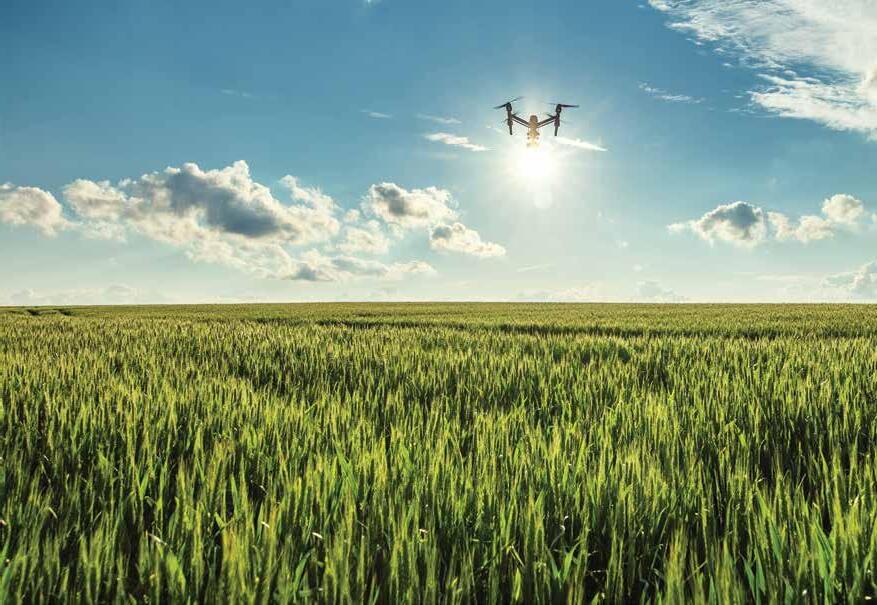
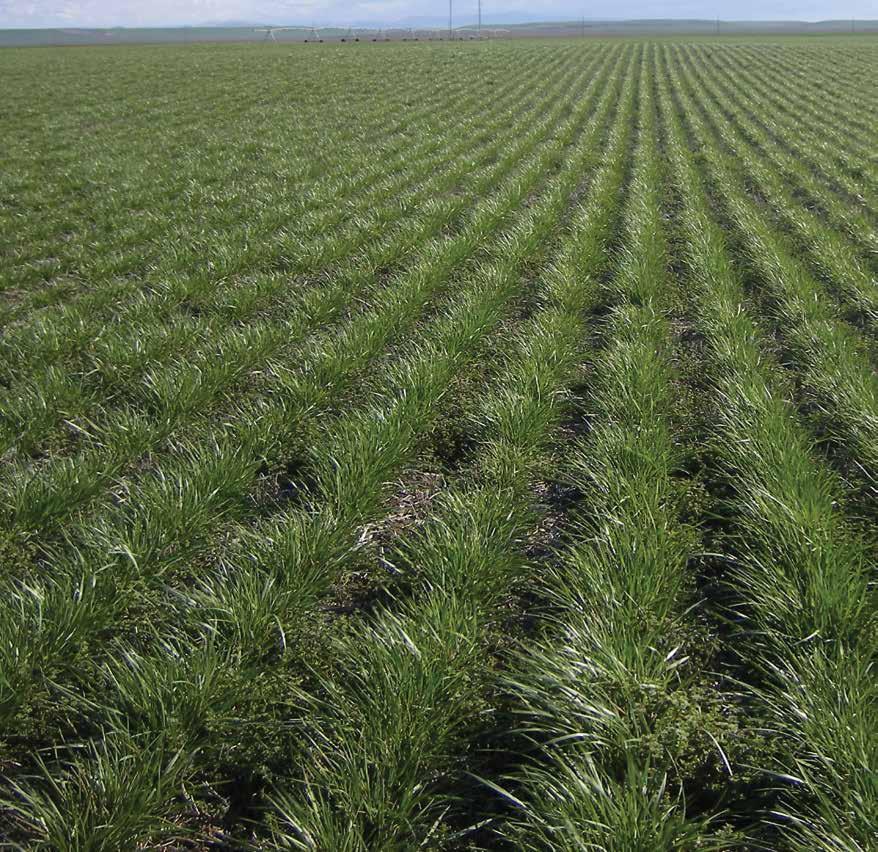

ALL INFORMATION CONTAINED HEREIN IS PROVIDED “AS-IS”, AND WILBUR-ELLIS COMPANY LLC (“WILBUR-ELLIS”) HEREBY EXPRESSLY DISCLAIMS ANY AND ALL REPRESENTATIONS AND WARRANTIES WITH RESPECT TO THE INFORMATION CONTAINED HEREIN, WHETHER EXPRESS OR IMPLIED BY LAW OR OTHERWISE, INCLUDING, WITHOUT LIMITATION ANY WARRANTY OF COMPLETENESS OR ACCURACY AND ANY WARRANTY OF FITNESS FOR A PARTICULAR USE OR WARRANTY OF MERCHANTABILITY. WILBUR-ELLIS SHALL NOT BE LIABLE FOR ANY DIRECT, INDIRECT, CONSEQUENTIAL, SPECIAL, OR INCIDENTAL DAMAGES ARISING OUT OF USE OF THE INFORMATION CONTAINED HEREIN OR ANY SERVICES PROVIDED BY WILBUR-ELLIS RELATED THERETO. For information only. Not a label. Prior to use, always read and follow the product label directions. WILBUR-ELLIS logo, and The Power of We are registered trademarks of Wilbur-Ellis Company LLC. AeroTract is a registered trademark of JH AeroTract LLC. K-260105 POWERED BY Contact your local Wilbur-Ellis representative to discover how you can harness The Power of We ® at bit.ly/WeVAM or at 541-926-1200 .


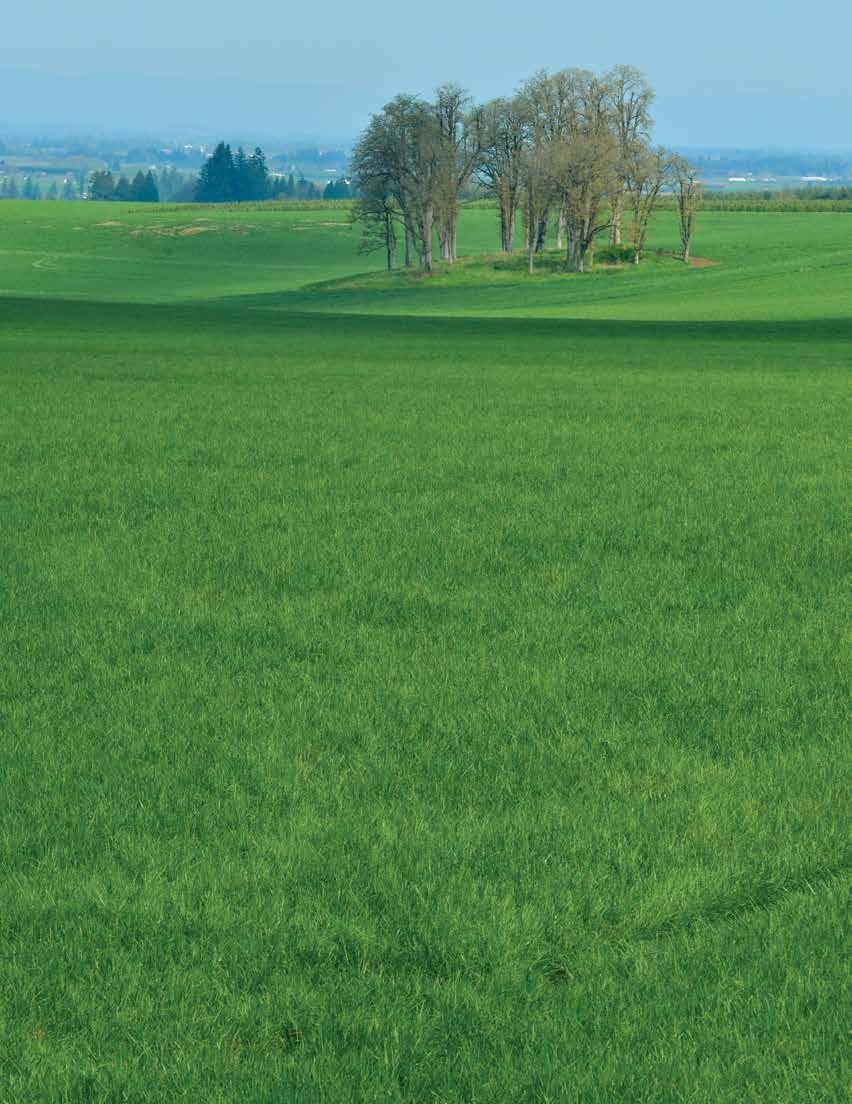

36 Seed Industry Loses Two Stalwarts Extension Report 40 Seed Council Update ................... 43 Commissions Update .................. 44 Research & Regulatory Report 46 Classifieds 48 Advertiser’s Index ........................ 48 Calendar ........................................ 48 8 Market Influences Mixed After Turbulent Two Years OREGON SEED COUNCIL OFFICERS AND COMMITTEE CHAIRS Executive Director Roger Beyer 494 State Street, Suite 220, Salem, OR 97301 503-585-1157 • oregonseedcouncil.org Officers Becky Berger, President Kate Hartnell, First Vice President Alex Duerst, Second Vice President Emily Woodcock, Treasurer Orin Nusbaum, Immediate Past President Committee Chairs Eric Bowers Chairman of the Legislative Committee Troy Hadley Chairman of the Smoke Management Committee Doug Duerst Chairman of the Public Relations Committee Ralph Fisher Chairman of the Research Committee Tom Brentano Chairman of the Seed Services Advisory Committee Dawsen Koos Chairman of the Scholarship Committee Oregon Seed Magazine Post Office Box 3366 • Salem, Oregon 97302 Tel: (503) 364-3346 • Fax: (503) 581-6819 oregonseedcouncil.org /oregon-seed-magazine Publisher Bryan Ostlund Post Office Box 3366 • Salem, Oregon 97302 Tel: (503) 364-3346 • Fax: (503) 581-6819 Editor Mitch Lies Post Office Box 3366 • Salem, Oregon 97302 Tel: (503) 339-7898 • mitchlies@comcast.net Advertising Manager Shawn Anderson Tel: (503) 364-3346 • Fax: (503) 581-6819 shawn@ostlund.com 18 A New Era for Oregonians for Food & Shelter 3 Weed Science Research in Good Hands Despite Recent Losses 11 Clover Featured on New Bee License Plate 14 Barley Yellow Dwarf Virus: A Perplexing Concern in Grass Seed 22 Chuinard to Succeed Beyer at Seed Council 26 Blocking and Bracing: ‘An Important Issue’ 30 Northwest States Harmonize Sod Quality Standards FEATURES 31 Perennial Ryegrass Assessment Mechanism Changed 33 New Wave of Scientists Bear Promise for Oregon Seed Research 38 Growers Work to Avoid Build-up of Resistant Weeds SPRING 2023 1 Oregon Seed A Publication of the Oregon Seed Council VOLUME FOURTEEN • NUMBER TWO • SPRING 2023 Spring 2023 SECTIONS OregonSeedMagazineis published by the Oregon Seed Council in cooperation with Oregon’s grass seed commissions. Articles and columns cover the most current information on topics of importance to growers, the seed trade and others who value this industry. OregonSeedMagazineis published three times yearly, February 1, May 15 and October 1. Deadline for camera-ready art is four weeks prior to issue. EDITORIAL: Articles, announcements, photographs and drawings dealing with any aspect of the seed industry will be considered for publication. Editors are not responsible for views expressed in signed articles. All communications with or concerning articles, photos, etc. should be sent to OregonSeedMagazine PO Box 3366, Salem, OR 97302. PERMISSION: Editorial material may not be reproduced or photocopied in any form without written permission of the OregonSeedMagazinepublisher. SUBSCRIPTIONS: OregonSeedMagazineis circulated free to Oregon grass seed growers, members of the Oregon Seed Council, industry professionals and others who value the Oregon seed industry. OregonSeedMagazineis available, through subscription, to nonmembers. Cost is $25 annually, plus postage outside continental U.S.A. Back issues are available at $8.50 each. Publishers of OregonSeedMagazineassume no responsibility for accuracy and validity of claims in advertising or editorial reports. The opinions expressed by writers in by-lined articles are their own and not necessarily those of this magazine.
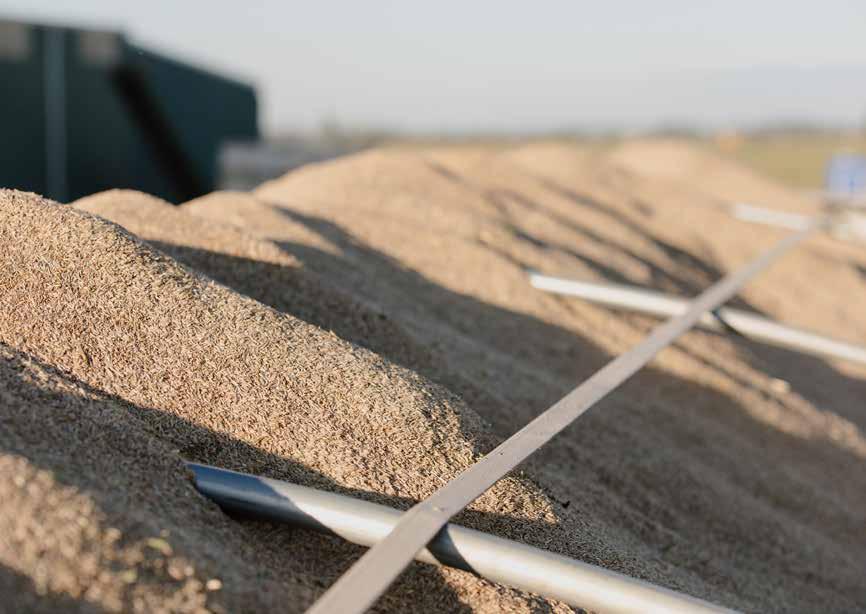
MARION AG SERVICE, INC
(503)678-5932
Conventional & Organic Fertilizer
Conventional & Organic Fertilizer
Lime & Dolomite Application
Lime & Dolomite Application
Variable Rate Application
Variable Rate Application
Seed Cleaning
Seed Cleaning
Pest Management
Pest Management
Research & Development
Research & Development
Scouting Services
Scouting Services
Testing & Analytics
Testing & Analytics
Crop Imagery/Sensors
Crop Imagery/Sensors
Sand Blasting/Paint Shop
Sand Blasting/Paint Shop
Sand Services
Sand Services
Grass Seed Contracts
Grass Seed Contracts


(503)678-5932
www.marionag.com
www.marionag.com
support@marionag.com
support@marionag.com


2 Oregon Seed Magazine
MARION AG SERVICE, INC
Growing Together ask us about ask usabout ask usabout ask usabout
Growing Together ask us about ask usabout ask usabout ask usabout
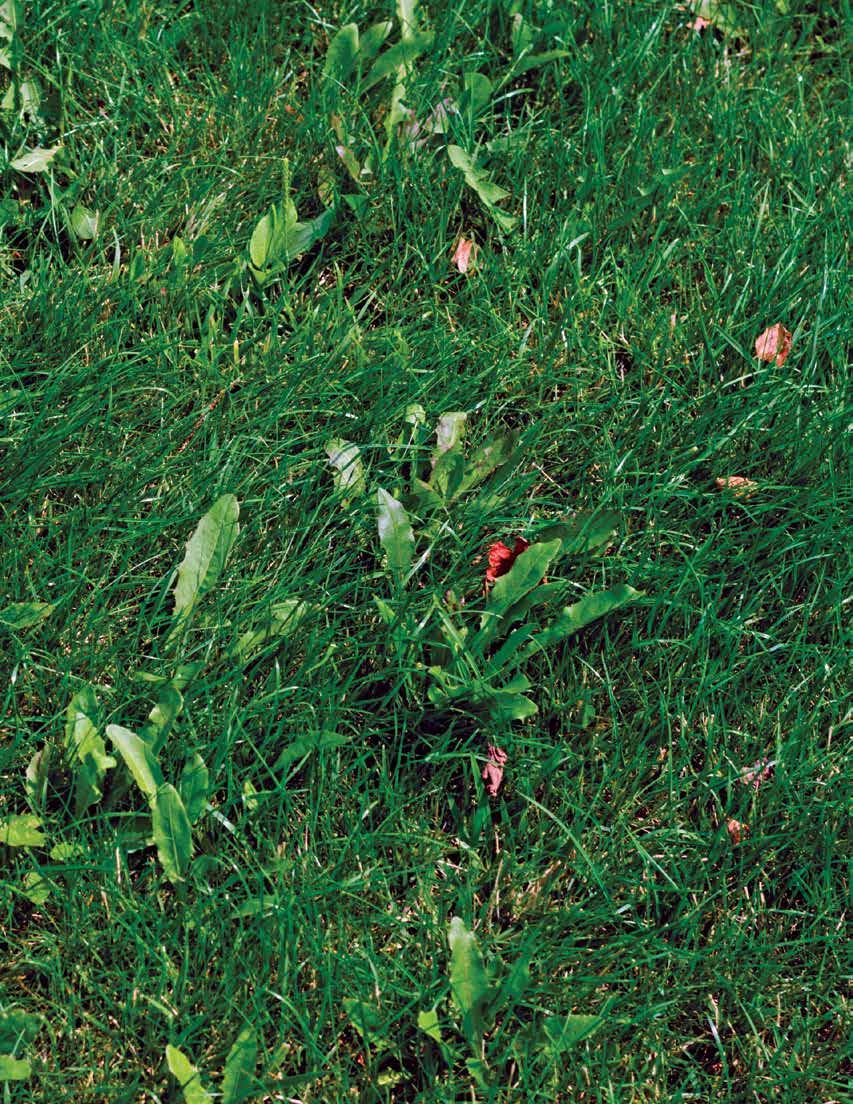
Weed Science Research in Good Hands Despite Recent Losses
Oregon State University has lost two weed scientists over the last 18 months, as Caio Brunharo, former assistant professor of weed science in the Department of Crop and Soil Science, left for a similar position at Penn State University, and former Extension Weed Management Specialist Andy Hulting left recently, as well.
Despite that, with the additions last year of weed scientists Pete Berry, who joined the OSU Department of Crop and Soil Science, and Clint Mattox, who joined the USDA Agricultural Research Service’s Forage Seed and Cereal Research Unit in Corvallis, weed management research in Oregon seed production is surprisingly robust going into the 2023 cropping season.
Pete Berry
In a presentation at the Oregon Clover Growers Annual Meeting, Berry outlined some of his goals for weed research in part by examining his experiences and how they are shaping his pursuits.
For the past four growing seasons, Berry was working for Syngenta in Illinois, where he worked on precision agriculture and what he characterized as classic herbicide analysis, looking at product efficacy and phytotoxicity. “It was a great experience for me. And getting to see the production scale of corn and beans was something I hadn’t seen before,” he said. “That was great training for me in terms of understanding agriculture outside of the specialty world I had been trained in.”
He also worked on incorporating precision agriculture into weed management through Geographic Information Systems and optical imaging.
In Oregon, Berry said he hopes now to utilize precision agriculture weed control, a task that will include calibrating the optical imaging technology used in precision ag for seed crops produced in Oregon, such as clover.
“This hasn’t been done yet in clover,” Berry said. “But companies, including a Dutch company, are very interested in having scientists look and say, ‘Hey, can we calibrate this?’”
In one sense, precision agriculture technology, in the form of a green-on-brown weed spraying system,
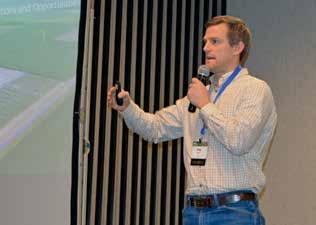
New OSU weed scientist Pete Berry at the Oregon Clover Growers Annual Meeting in February. Berry is interested in bringing precision ag technology into Oregon seed production weed control programs.
has been used in the Pacific Northwest since the 1990s. The system, where application equipment is calibrated to spray anything green in a field, is used extensively in wheat fallow operations.
The next iteration of that system, green-on-green, used in advanced systems, such as the John Deere See & Spray system, involves more advanced technology, where a sprayer can differentiate between a green crop and a green weed.
Berry believes that calibrating a green-on-green system for Oregon grown specialty seed crops will take
(continued on page 4)
SPRING 2023 3
(continued from page 3)

some time but is doable. “If you think about how curly dock looks relative to some of these clovers, well, it looks pretty different … so we can potentially calibrate the sprayer to recognize the weed,” Berry said at the Clover Growers Annual Meeting.
A more medium-term goal for Berry involves incorporating aerial imagery in precision ag. “This is a little bit longer process, where we can fly over a field, we can image it, and then using computer software, we can say, ‘Okay, I want you to select what is the crop and what is not the crop,’” he said.
“The idea is to isolate a specific weed at a known GPS coordinate by aerial imagery and then program a sprayer to target that specific spot in the field,” Berry said. “This could mean a single nozzle activated or multiple nozzles, based on the size of the weed or weeds in a given area.
“What I am doing is saying, ‘Okay, at this specific coordinate, I want you to turn on the application.’ And it could be the size of this stage or the size of my fist. So, a single nozzle would turn on or all the nozzles would turn on as it passes over that system,” he said.
Berry said he is working with a company to try and bring that technology to Oregon, as well.
“There are some limitations with this,” he said. “And it really comes down to computer processing, because when you are imaging a field, there are a lot of individual pictures to compile together. And when I say a lot, for a three-acre field there are about 9,000 images that I have to compile and it takes hours for a computer software to do this.
“But as we get better computing systems, it becomes how big can we go,” he said.
“So, that is the long-term goal,” Berry said. “But until then, we can still utilize some of these systems that were created for large-acreage row crops in a way that allows you to take advantage of these technologies (in specialty seed crop systems).”
Clint Mattox
Having worked as a golf course superintendent for most of the past ten years, Mattox comes to the USDA ARS Forage Seed and Cereal Research Unit from the golf course side of the grass seed industry. Prior to that, he earned a Ph.D. from OSU in turfgrass management.
“I know a lot about grasses, and so when the job opportunity came up to be a research weed scientist, it felt like a good fit for me because I wanted to stay
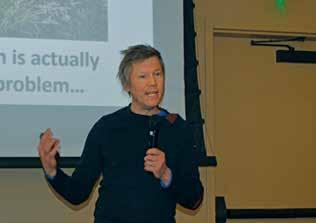
ARS Weed Scientist Clint Mattox at the OSU Extension Seed and Cereal Crop Production Meeting in January is looking at a novel approach to long-standing efforts to control annual bluegrass in grass seed production systems.
in Oregon and work in grass production systems,” he said.
Mattox said he plans to focus on grassy weeds that are difficult to control in grass seed production systems and he plans to start with annual bluegrass.
One approach he is researching involves preventing annual bluegrass from going to seed, which could help growers get on top of the problem before it gets out of hand.
“Sometimes I think about this weed problem really being a weed-seed problem,” Mattox said. “So, if we keep annual bluegrass from going to seed in our system, manage it perhaps using more residual or preemergent herbicides to start, we can possibly reduce the population enough so that it is not so daunting that we just feel hopeless and have to apply a postemergence application, as opposed to maybe going out with a rogueing crew.”
Mattox added that when using the labeled rate for post-emergence herbicides in grasses, it often isn’t sufficient to kill annual bluegrass. “And so, any annual bluegrass that survives is being exposed to a nonlethal dose, which is a recipe for herbicide resistance,” he said.
“Annual bluegrass is an amazing plant,” he added. “It is a very hardy plant and it is a really difficult menace. There is a huge potential for genetic variation and a huge potential for herbicide resistance to occur in this kind of grass plant, just because the genome is so large and there is so much diversity.
“So, what we need to do in my opinion is try to reduce the amount of annual bluegrass growing

between the rows using these residual chemistries, which will make it possible to rogue,” he said.
Ryan Hayes, research unit leader of the ARS Forage Seed and Cereal Research Unit, said he is impressed with the innovation Mattox is bringing to a longstanding problem in seed production.
“Clint really impresses as a systems thinker, someone who understands how the diverse objectives of crop production are interrelated,” Hayes said. “I think we’ll see him attack longstanding weed control problems in ways that rest of us have failed to recognize, all with an eye on productivity of the entire system.”
Regarding Berry, Nicole Anderson, OSU Extension seed production specialist, said she believes he has the potential to take weed science research in a different direction than where it’s historically been.
“(Emeritus weed science professor) Carol Mallory Smith’s career at OSU was centered on understanding the mechanism behind resistance and, of course, she did an excellent job of that. She is known around the world for the contributions she’s made in that field. And now Pete’s focus is less about understanding resistance and more about looking at alternative management strategies to try to deal with resistance,” Anderson said.
“And he is bringing in some background, both from his training in precision ag and his background of working in the private industry,” Anderson said.
“I think his work with precision ag and utilizing technologies to better manage weeds is going to pair nicely with the new precision ag position that the Department
of Crop and Soil Science is hiring specifically for seed crops,” Anderson said. “So, I think he is going to be a big contributor to that team that tries to help us understand and utilize new technologies in seed crop production.” F

Pub/s: Oregon Seed Traffic: 3/28/23 Run Date: 5/15/23 Color: CMYK Author: TH Trim: 4.9375”w x 7.375”h Live: n/a Bleed: n/a Version: 2
name. Same
to cash patronage. Northwest FCS is now AgWest Farm Credit. And we’re still committed to sharing profits with our customers. Patronage continues to be a unique benefit of our cooperative structure, providing earnings from our association back to our customer-members. This year, patronage dividends total $366.5 million to eligible customers throughout the West. It pays to be an AgWest customer. Grounded by tradition. Inspired by possibility. Contact your local branch or visit AgWestFC.com to learn more. This institution is an equal opportunity provider and employer. AGWEST 17163-63 CashPatronage_4.9375x7.375_Oregon Seed_v2.indd 1 3/23/23 10:30 AM
New
commitment

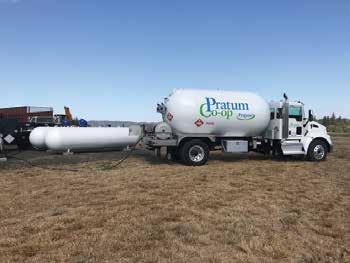

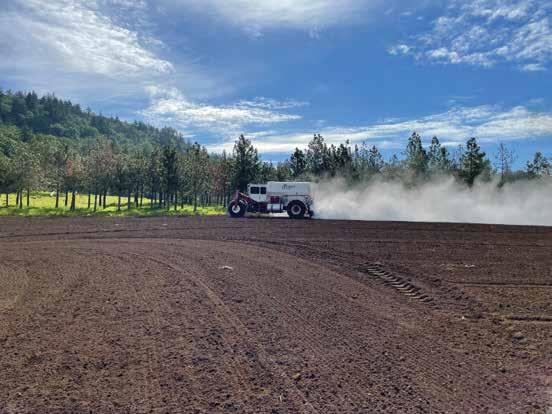
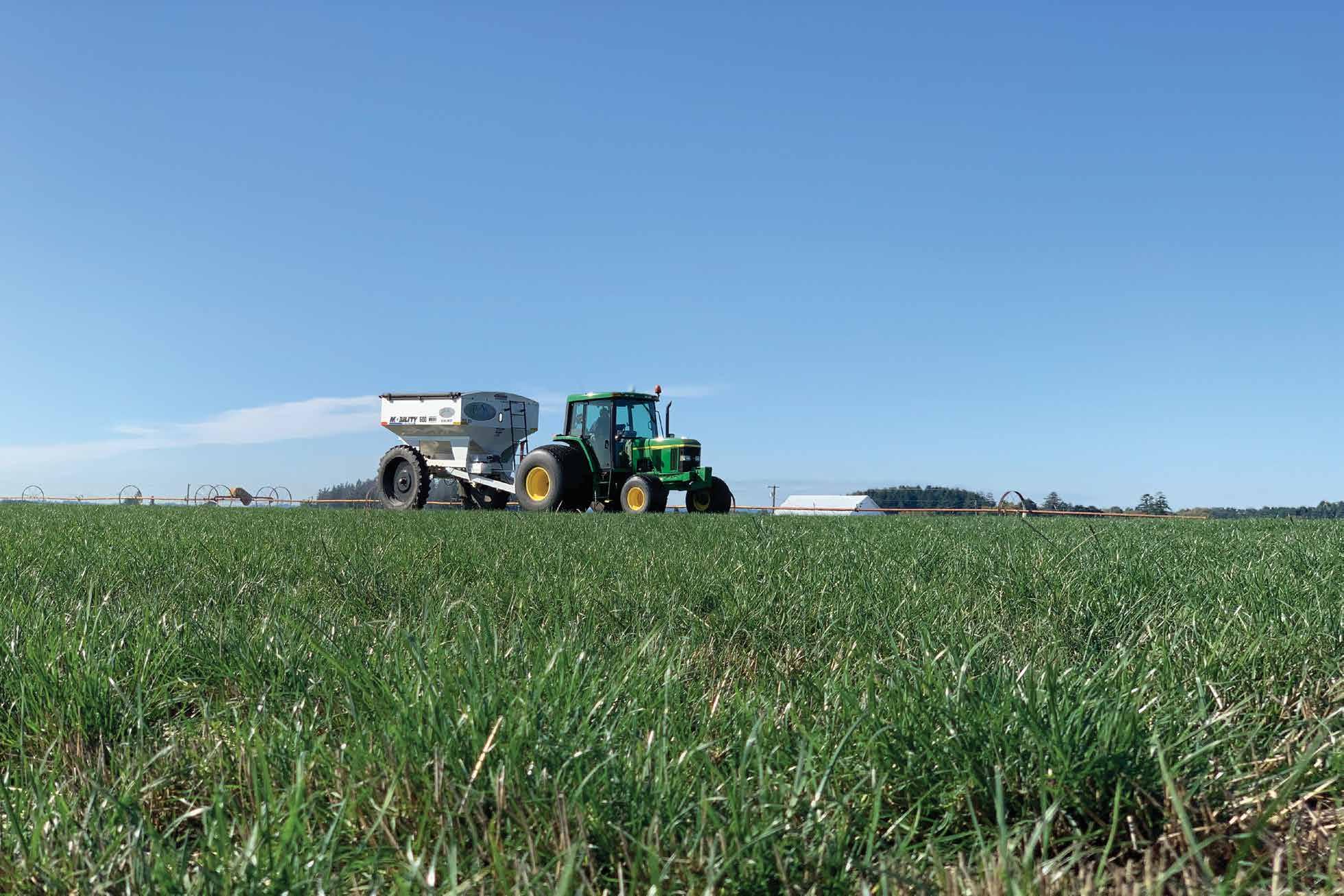

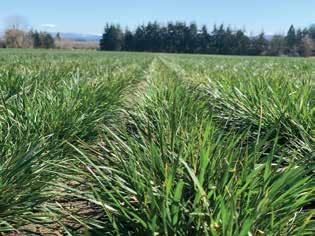



Market Influences Mixed after Turbulent Two Years
As the calendar turned to April, grass seed company executives were hoping for a strong finish to a spring market season that hadn’t lived up to hopes.
“So far, the spring market has not developed into being what I would call a great season,” said Mike Baker of Willamette Valley Assured. “I think the Southeast and parts of the Mid-Atlantic have been pretty good. But the Midwest and the Upper Midwest have been cold with above normal snowfall and, as a result, we don’t see as much activity as we would like in those areas.”
“We need the weather to cooperate in the next two months to really move some of this inventory,” said Scott Harer of Columbia Seeds.
The developments come after two years of unprecedented market conditions, including record high prices in 2021 and a dramatic drop in price after cold, wet weather scaled back seed consumption in the spring of 2022.
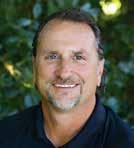
Of immediate concern as the spring market of 2023 got underway, according to executives, is a pipeline that if not crammed full of seed was at least uncomfortably high, particularly when it came to perennial ryegrass.
“It is certainly not ideal,” Sean Chaney, vice president of wholesale for DLF USA, said of the inventory. “I think, in general, the industry has too much perennial ryegrass, but we’ll get through it and we’ll be fine.”
Tall fescue seed supplies were slightly lower, he added, in part because tall fescue was being substituted in some seed mixtures for fine fescue due to crop failures in Canada last year. “Tall fescue has benefitted some from changes to retail formulas reducing the amount of fine fescue due to supply issues the last two years,” Chaney said.
Still, he said, tall fescue seed supplies were a little higher than some companies would like, in part because China hadn’t purchased much of late.
The executives were keeping their eyes on several potential developments in early April, including whether China comes back into the U.S. seed market and, if so, to what degree; whether the Southwest market improves this year after rainy weather there increased irrigation opportunities, which could lead to more seed purchases; will retail markets extend into June if spring planting is delayed; will shrinking European supplies open that market for U.S. seed shipments; and will the Oregon Grass Seed Bargaining Association (OGSBA) get a price established, a development that failed to occur last year.
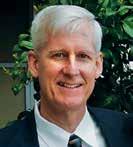
“In terms of stability and ease of doing business for everyone in the chain, I think it’s beneficial to have an OGSBA price, to get back in the swing of things and get back to business as

8 Oregon Seed Magazine
Mike Baker

“I would say that it would be very important to have an OGSBA price,” Baker said.
As for China movement, Chaney said he is particularly interested in how active they become in buying perennial ryegrass seed for sod overseeding.
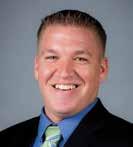
“If they come back in and buy a bunch of perennial ryegrass seed from us here in North America, then that will help start to bring down that inventory that the industry is sitting on,” Chaney said.
Of late, according to Baker, about the only grass seed China was buying from the U.S. was some of the low-priced annual ryegrass that has been available and lower quality Kentucky bluegrass.
Southwest Factor
Increased movement in the Southwest, once a strong market for Oregon seed producers, also could play a factor in removing inventory and easing downward pressure on price this year, Baker said.
“We haven’t sold a lot of seed in the Southwest recently because of the ongoing drought down there,” Baker said. “But this year, because there is more water, you would think we could sell more.”
As for whether the retail season could extend into June if spring continues to bring poor weather conditions to the Midwest, Harer said that could occur.
“I’ve seen that in a couple of seasons where you had a delayed spring, but then the summer movement was pretty good, so you never know,” Harer said. “But typically, the benchmark is that we have until Memorial Day Weekend.”
As for whether the European market opens back up, that is a possibility, Chaney said, given that European grass seed companies dramatically scaled back production acres this year after experiencing an oversupply last year, a fact that could present some opportunities for U.S. exports.
“A lot of the companies over there were pretty prudent coming out of crop ’22, which was a huge crop for them in Europe,” Chaney said. “I think overall acres are going to be reduced for crop ’23 and still more for crop ’24. And, if someone over there needs something with a little higher mechanical purity and better overall quality, then we might see some sales there.”
Still, Chaney said, the price discrepancy between North American and European seed is large enough to make selling there difficult for U.S. companies.
Crop Size
Another factor that could influence price this year and next spring is the size of the Oregon crop, which as of early spring, was not looking that good.
“The prospects for good yields are not good,” Chaney said. “We didn’t really get any measurable amount of rain last fall until the third week of October, at which time the soil temperatures were already
(continued on page 10)

SPRING 2023 9
Sean Chaney
(continued from page 9)
starting to decline and nothing really grew.
“Many annual ryegrass stands were only two or three inches tall going into the winter,” Chaney added. “That just tells you how little growth happened during the fall planting and recovery season.”
Particularly, tall fescue acres appear to have been dinged by fall conditions, Chaney said, given that the species has a high reliance on fall recovery to put on reproductive tillers.
“That will most likely limit the yield potential of tall fescue,” Chaney said. “And then, of course, with the cool temperatures extending now into April, it is just going to shorten the spring growing and reproduction window for tall fescue.”
Also, Chaney said, vole damage appeared high, particularly in established tall fescue stands.
“We are seeing vole damage being pretty rampant throughout the Valley on all crops, but especially on tall fescue stands that are a bit older where some of those vole colonies have had time to expand, grow and thrive.
“So, between those things, I think it is likely that we’re going to see a decrease in yield,” Chaney said.
soybean plantings often lead to a late harvest, which is never good for the cover crop market.
“I am not saying that it will be late harvest yet, but it has certainly been cold in the entire Midwest and Upper Midwest,” Baker said.
Baker added that late plantings in the Midwest last year led to a late harvest, which “did impact somewhat the cover crop market.”
“It certainly impacted the radish usage, because of the need to get radish as mature as possible before it freezes up,” Baker said. “We just lost the tail end of that season because the crops came off so late. And we certainly run that risk again this year.”
As to whether the industry will ever see prices like during the COVID pandemic, Chaney said he seriously doubted it.
“I don’t see us touching those highs ever again,” Chaney said. “That was a combination of demand that we’ve never seen before, coupled with a crop that was by a lot of estimations a disaster.
“So, it was kind of a worst-case scenario in a lot of ways,” he said. “We needed a big crop and we got a small one. And it wasn’t just one species. It was



10 Oregon Seed Magazine
Leading The Serving the Willamette Valley for the last 50 years. Thank you for your trust. Cornelius 503.640.2371 | Dayton 503.868.7510 Rickreall 503.623.3101 | Hopmere 503.393.1141 Corvallis 541.249.9609 | Tangent 541.928.3391 NutrienAgSolutions.com Nutrien Ag Solutions® ©2019 Nutrien Ag Solutions, Inc. All Rights Reserved
Clover Featured on New Bee License Plate
ARed clover is front and center on Oregon’s latest custom license plate, the Pollinator Paradise license plate, which celebrates bees. A big reason why, according to Andony Melathopoulos, Oregon State University Extension pollinator health specialist, is the work clover growers have done in collaboration with beekeepers to protect pollinator health.
Speaking at the Oregon Clover Growers Annual Meeting in February, Melathopoulos commended clover growers for sitting down with beekeepers five years ago and ironing out bee protection protocols.
“The way we have worked together the last five years is a big part of the impetus for including clover on this new license plate,” Melathopoulos said.
When he approached the plate’s artist, Marek Stanton, a then 15-year-old bee enthusiast from Eagle Rock, Oregon, about creating art for the plate, Melathopoulos said the instructions were clear: “We said, ‘We want three things. There has to be a clover field, there has to be a honey bee and a bumble bee.’”
Melathopoulos said what happened next surprised even him. Presales for the plate opened on January 19 and within two weeks, 3,000 vouchers were sold, a requirement for the plates to go into
production. The pace of the presales was a record for the Oregon DMV, Melathopoulos said. “Soon everyone in the state was aware of the connection between Oregon clover and bees. The Oregonian ran a piece, and it was very popular with a thousand shares.
“Much of the press pointed out that the plate is an indicator of how well the state is managing its bees and that our red clover fields support the highest diversity of bumble bees of any crop in the nation,” Melathopoulos added.
Moreover, he said, the attention brought greater public awareness to the Oregon Clover Commission’s Bee Protection Protocol, a document developed to protect bees by growers, beekeepers, crop consultants and OSU Extension.
“The message of the plate has reached urban areas like Portland that crops like clover really matter when it comes to bee health,” Melathopoulos said.
The plates have a $40 surcharge when ordered, along with regular title, registration and plate fees. For each sale, $35 goes to support bee research at OSU.
“My hat’s off to Andony and company for making that whole thing look easy,” said Bryan Ostlund, administrator of the Oregon Clover Commission.
(continued on page 12)

SPRING 2023 11
Oregon’s new Pollinator Paradise license plate.
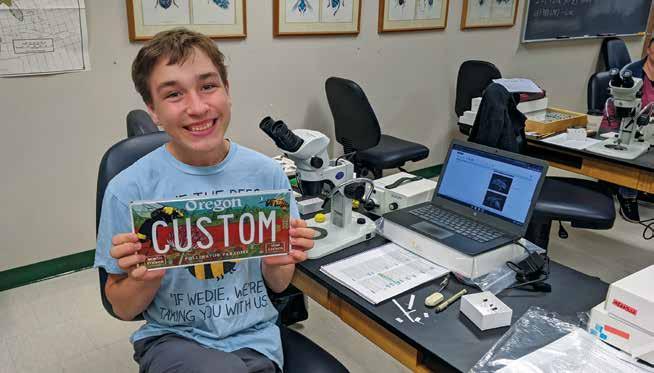
“We have looked at those specialty plate programs before and the bar is incredibly high, both in regard to the number of plates you have to sell right out of the chute and in terms of annual commitments to maintain that plate. And then you have a large financial commitment to even submit your application to the DMV.”
Ostlund added that he was surprised at how quickly Melathopoulos and his team were able to generate the initial sales.
“We in agriculture get that the health of pollinators is a very significant issue,” Ostlund said. “But you kind of wonder if others do. And so, a lot of us were skeptical. But boy, once Andony had that plate off and running and started offering vouchers, man did he make that look easy.”
Another interesting angle to the creation of the Pollinator Paradise license plate is the artist behind the plate. At the Clover Grower Annual Meeting, Melathopoulos said he had been engaging with Stanton as part of Melathopoulos’ work in the Extension Service’s Master Melittologist program.
“We were online during the pandemic, and this person named Marek asked detailed questions of bee biology, and I was sure he was 65 and retired or something,” Melathopoulos said. “He turned out to be this 15-year-old kid.”
Melathopoulos later learned that Stanton was an illustrator and a year later, he was working with Stanton on drawing art for the plate.
The plate features a managed honey bee and a wild yellow-faced bumble bee hovering over a field of red clover with bee colonies in the background against a backdrop of blue sky and fir trees.
The main impetuses behind the plate, according to Melathopoulos, are to increase awareness of the importance of pollinator health and to generate research funding. (The Oregon gray whale license plate, for reference, has generated approximately $1.5 million in sales and renewals since its release in February of 2019.)
And along the way, the plate certainly isn’t hurting the reputation of clover growers.
“I think we’ve got some great press for this industry, as you deserve,” Melathopoulos told growers. “You have been working hard and I look forward to doing more work in clover.”
With presales of the plate complete, the plates are going into production and should be available at DMV offices before the end of the year, Melathopoulos said.
For the latest information on the plates or to see the research it supports, visit oregonbeeplate.org F
12 Oregon Seed Magazine
(continued from page 11)
Marek Stanton, a bee enthusiast from Estacada, Oregon, created the artwork for the Pollinator Paradise license plate. He was 15 years old at the time.
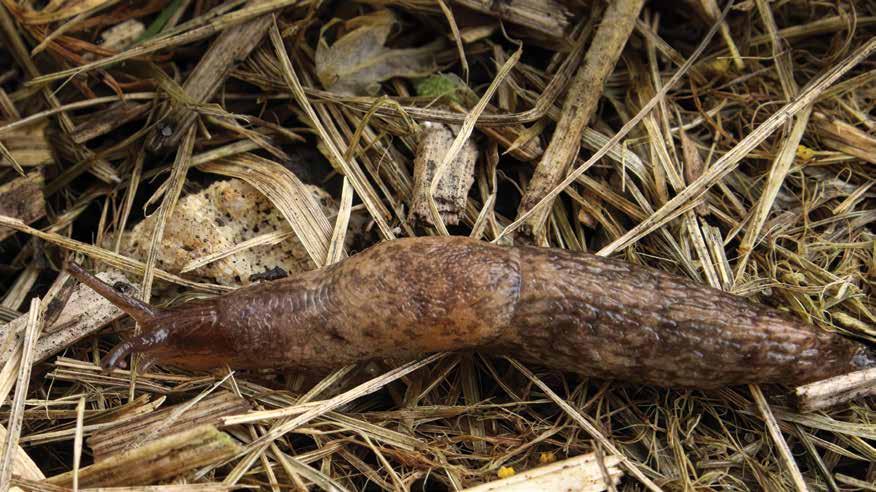
Year-round performance no matter the weather
There are few guarantees in farming, but Ferroxx® Slug and Snail Bait and Ferroxx®AQ Slug and Snail Bait are exceptions. This family of iron baits performs through all seasons, no matter the weather.
This is good because slugs lay eggs year-round. They’re super busy from early fall to spring. Plus, they can even keep it up through early summer. These eggs hatch into juvenile slugs that become your problem next year.
Not anymore. Ferroxx iron baits are efficacious against adult and juvenile slugs. Baiting appropriately through next spring can break the slugs’ life cycle. This stops them from becoming destructive pests next fall. For extremely wet conditions, such as standing water, use Ferroxx AQ, our AQuatic bait!
Proven performance and value.
SPRING 2023 13 Neudorff North America 250-652-5888 • Neudorff Pro.org
© 2021 Neudorff North America, all rights reserved.
Barley Yellow Dwarf Virus: A Perplexing Concern in Grass Seed
One year of data from multi-year research into aphid-vectored barley yellow dwarf virus (BYDV) is showing that a first-year perennial ryegrass stand treated with low rates of nitrogen can yield as good or better than a first-year stand of the same variety treated with high rates of nitrogen. The reason: There was more aphid transmission of (BYDV) in the stand treated with the higher rates.
Researchers expected to see higher aphid counts and more BYDV incidence in the higher-nitrogen plots, given that aphids are attracted to green tissue, said USDA Agricultural Research Service Plant Pathologist Hannah Rivedal. So, in one respect, the findings weren’t particularly surprising. But, she said, they are potentially significant.
“You can potentially get away with a lower rate of nitrogen, have less yellow dwarf virus infection and not have significant yield loss in a first-year perennial ryegrass field,” Rivedal said. “At least in this trial, there was no statistical difference between those two treatment groups, which is interesting.
“We are wondering if these trends will hold true as we get into future years of the trial,” she added.
The finding was one of many that the research team has uncovered in the initial stages of the trial, which is being led by Rivedal and USDA ARS Entomologist Seth Dorman. Rivedal and Dorman work out of the ARS Forage Seed and Cereal Research Unit in Corvallis.
Researchers also found that the number of aphids in a stand didn’t necessarily correlate to the amount of BYDV incidence. “You may expect that because there are a lot of aphids in these hot spots in the south part of the Valley that we have a lot of barley yellow dwarf virus incidence,” she said. “Well, we really don’t see that.
“We see yellow dward virus pressure throughout the Valley,” she said. “So, just because we have lower populations (of aphids) doesn’t mean we don’t have the virus circulating in our system.”
Researchers also found that certain varieties of ryegrass are more tolerant to BYDV than others.
Difficult to Spot
In a presentation at an OSU Extension Seed and Cereal Crop Production Meeting, Rivedal characterized efforts to control BYDV as challenging, particularly in grasses grown for seed where disease symptoms are difficult to spot.
“In cereal crops, we are going to see leaf chlorosis or necrosis,” she said. “You will see discoloration from yellow to red. You will likely see stunting and overall yield reduction.”
In tall fescue, symptoms of BYDV infection include flag leaf reddening and, depending on the cultivar, possibly some stunting. But symptoms are much more subtle than in cereals. “If you are not deeply scouting in your field, you may not catch this and you could easily confuse this with some other type of damage,” she said.
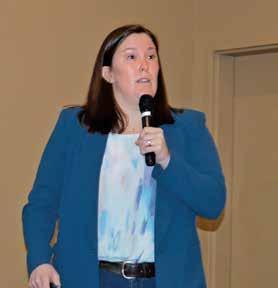
In perennial ryegrass, yellowing of leaf tips is a common symptom of BYDV infection. Again, she said, it can be easy to miss without regular scouting. “In general, we have much more subtle symptoms (in grasses grown for seed),” she said, “and it is certainly not consistent.”
BYDV can also cause poor root development in grasses grown for seed. “But you are not necessarily
14 Oregon Seed Magazine
Hannah Rivedal at the OSU Seed and Cereal Crop Extension Meeting in January presents one year of data from a multiyear research project into aphid-vectored barley yellow dwarf virus.
going to be able to see that until you have a large-scale dieback,” she said.
She added that symptoms of BYDV infection are only visible at temperatures under 85-degrees Fahrenheit. “Hot temperatures stop replication of the virus and basically eliminate those symptoms,” she said.
Multiple Hosts
Adding to the challenge to control the disease is the fact that aphids, which transmit the disease, can enter a production field from multiple sources and at multiple times of the season, in part because of their wide host range and their propensity to seek out green tissue.
“There is a lot of outside interaction going on as the plants continue to mature through the summer,” she said. “This is a challenging system to be working in. We have virus-infected plants and alternate hosts of the virus and aphids. And, beyond that, the symptoms
(continued on page 16)
Aphids are pictured in tall fescue.
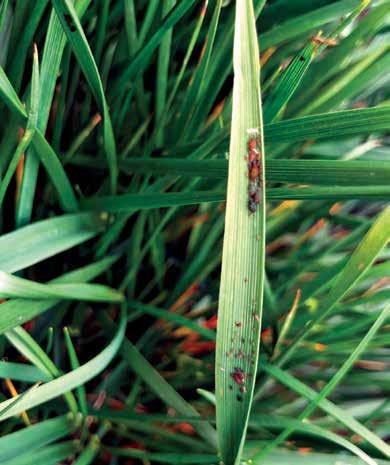

SPRING 2023 15
(continued from page 15)
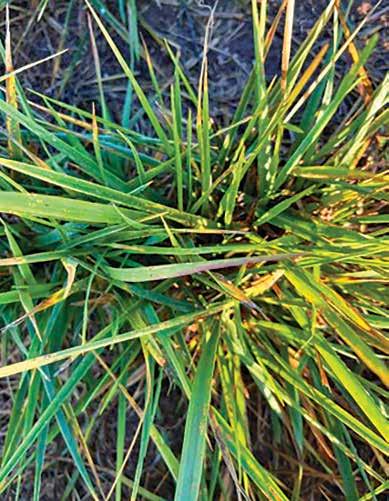
are subtle, so it is hard to know where exactly infection is occurring.”
Also, she said, multiple virus species are involved, and several aphid species can be transmitting the viruses, with the bird cherry oat aphid being the most important species in Oregon.
In annually seeded crops, such as cereals, there is more opportunity to minimize disease risk with measures like adjusting planting dates and applying a seed treatment. In perennial grass seed crops, those options aren’t as viable.
The bird cherry oat aphid typically has a spring and a fall flight. After its fall flight, if it is mild enough, it can survive in seed production fields and transmit the virus to the plants over an extended period.
“This fall flight and infection is especially detrimental to our first-year stands,” she said. “That is when our plants are most susceptible to that infection. And you’re not going to be able to cure that plant throughout its life cycle.
“I also think it is important to be mindful of the fact that we have weedy hosts, which these aphids can move into, acquire and transmit the virus and as
we get into the spring, aphids will feed and transmit viruses throughout our grassy fields,” she said. “This is the time of year when you would likely see symptomology in the field.”
Highly Variable
In the first year of the multi-year research project, Rivedal and Dorman surveyed multiple production fields in the Willamette Valley, as well as in Central and Eastern Oregon for disease incidence in plants and monitored aphid counts through use of sticky cards and sweep nets over a 30-week period. The researchers also are documenting environmental factors and whether growers were applying insecticides and what rotations were nearby.
“We are incorporating that into some risk modeling, and then we are identifying the viruses in the aphids and in the plants,” she said.
Looking at just the Willamette Valley, in weekly scouting, researchers recorded aphid counts ranging from less than 100 to over 2,000 aphids. “So, we had a really broad range throughout the Valley,” Rivedal said.
In looking at potential control tactics in perennial ryegrass, researchers tested five different application timings of Sivanto, a systemic insecticide with a proven track record against aphids, including a fall only and a spring only timing to target the aphid’s peak flights, as well as a combination spring and fall timing, and a fall, spring and summer combination, with the summer application coming just before harvest. They also had an untreated control.
To measure efficacy, researchers collected sticky cards weekly and monitored with sweep nets after spray dates for accurate aphid counts. They also collected plants and analyzed both plants and aphids for presence of the virus with PCR analysis.
Preliminary data showed that where Sivanto was sprayed, there were significantly lower aphid counts, particularly in the spring only timing and in the combination sprays, and particularly in the perennial ryegrass variety that showed the most susceptibility to BYDV.
“We had a really cool, wet spring (in 2022) that was very conducive to aphid reproduction,” Rivedal said. “So, spring was a very important time for us to have some sort of control.”
As for clean-seed harvest, the variety most susceptible to BYDV had statistically greater seed yields under the spring only and combination sprays.
Researchers plan to continue looking at yield and economic return on investment of the different spray programs over the next three years. F
16 Oregon Seed Magazine
Barley yellow dwarf virus symptoms are pictured in tall fescue.
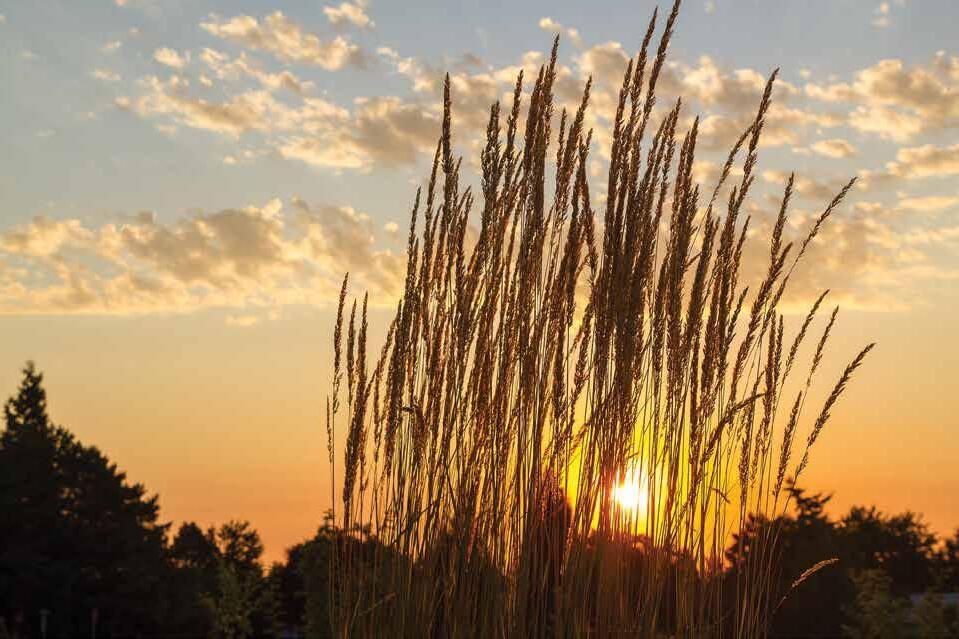
Follow all directions, restrictions, and

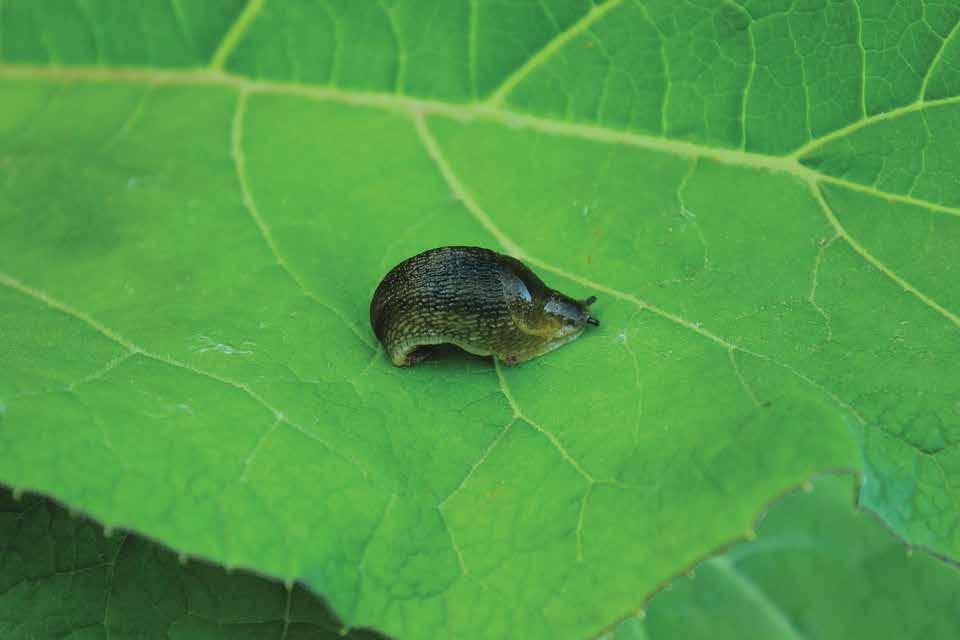
DUO is a unique proprietary blend of 2 different active ingredients. 50% Slugger 4.0 (Metaldehyde) and 50% BioSul (Sulfur).
DUO is a premium rain fast pellet.
DUO has a wheat based attractant package.
In replicated trials, both Slugger 4.0 and BioSul killed 50% of slugs by day 2, and over 90% were dead by day 5.
OR-CAL,
Junction
INC 29454 Meadowview Rd
City, OR 97448 Roger Hafner Cell: 541-974-1712 Roger@O inc.com
• • • •
Standard,
precautions ON THE LABEL A Great Alternative to
Single Active Ingredient Baits IN GRASSES AND WHEAT

A New Era for OFS
Under the leadership of Executive Director Katie Murray, Oregonians for Food and Shelter (OFS) is playing to its strength these days, namely the breadth of its membership, and concentrating on outreach more than at any point in its four-plus decades of operation.
The nonprofit agribusiness organization is hosting more tours than ever, including eight last year in which it connected dozens of elected officials with farmers and foresters. It is participating in more agriculture and forestry conferences, including 15 last year. And it is reaching thousands of people through newsletters, social media and other communications.
And, Murray said, this could be just the start of its outreach.
“I think there is a lot more that we could be doing to help educate across the board and engage in different discussions, both on the policy, regulatory side and in the Legislature,” Murray said.
Murray, who joined OFS in 2020 after 14 years at Oregon State University’s Integrated Pest Management Center, said she noticed early on that outreach and education were needed to break through preconceived notions of some urban legislators about production agriculture and forestry.
“I think in every Legislature, there are always legislators on both sides who are willing to listen and who are more open to be educated on these issues. And I think those are the ones that we really have to work with,” Murray said.
“What we like to do is approach an urban legislator as a community member in Oregon, to get them out of the Capitol and bring them into communities where they have the opportunity to meet people one-onone,” said Tiffany Monroe, who joined OFS in the fall of 2021 as associate director of policy and outreach.
“In reality, we have a lot in common,” Monroe added. “So, we like to bring them in communities where they have an opportunity to meet people and talk about those core values that we all share and talk about things that are important to them, like safe food, food security, being clothed and fed and sheltered. And hopefully it sort of melts some of those hard-pressed assumptions that we have about each other.
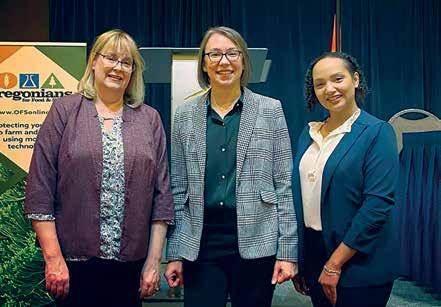
Oregonians for Food and Shelter staff at the organization’s first annual meeting last year, from left, Office Manager Diann Washburn, Executive Director Katie Murray and Associate Director of Policy and Outreach Tiffany Monroe.
“And once there is a connection, then we can talk about those issues on a more specific level and maybe help impact how they might make decisions regarding policy,” Monroe said.
“I think we’ve done a good job of trying to build some of those grassroots relationships to get those producers in front of legislators so they can tell their story and maybe see the differences and the similarities between organic and conventional crop production, and how they have a lot of the same issues,” said Office Manager Diann Washburn, who has been with OFS for more than nine years, spanning the new and old executive team.
Advocacy Framework
OFS is often pigeon-holed as a representative of the pesticide industry, Murray said. But the organization’s breadth of representation and its advocacy extends well beyond the producers of pesticides and fertilizers. OFS represents many Oregon producers, she said, and frames its advocacy
18 Oregon Seed Magazine

around three-pillars: science-based policy, innovation and stewardship.
“Those pillars provide us some avenues for communicating with legislators who would benefit from a more science-based view of pesticides,” Murray said. “We can kind of reframe the discussion from ‘Oh, you’re just the pesticide industry,’ to, ‘Well, there is some science underlying why pesticides are used and why they are necessary in many cases.’
“And, if we can get in the door with some of these bigger picture viewpoints, maybe we can make some headway in reshaping their opinions or at least soften their stance,” she said.
“As much as we have all this technical background about pesticides, it is often a social issue,” Murray added. “And that makes it a challenge. There are a lot of instances where it is an issue where people have their perceptions and they don’t make sense scientifically, but that is what we are working with. And if we can educate them and show them how the responsible use of pesticides benefits society, we can go a long way toward breaking down those perceptions.”
Further, Murray said, OFS represents a tremendously broad coalition of Oregon’s natural resource industries and to pigeonhole its advocacy is way off base. “From my perspective, this organization is an amazing coalition that is so much more than just the pesticide industry. Between the agriculture and forestry organizations we represent, we’ve got, I think, probably the largest natural resource coalition in Oregon.”
Numbers-wise, the organization has about 500 members, Murray said. But many of those 500 members are organizations that represent hundreds if not thousands of producers and other natural resource industry professionals.
“On the ag side, we have well over a dozen different commodity groups represented,” Murray said. “So, that represents many thousands of growers. And on the forestry side, it’s the same. So, when you line all of those up, we are speaking for a large portion of the natural resources industry in the state.”

History of Stability
For most of its 44 years, OFS has enjoyed remarkable stability: Paulette Pyle served as OFS director of grass roots for 35 years, retiring in 2015, and Terry Witt served as executive director for 25 years, retiring in 2012.
Since Witt’s retirement, OFS has had three executive directors: Scott Dahlman served in that role from 2012 to 2015; Katie Fast served as executive director from 2015 to 2019; and Murray now has twoand-a-half years under her belt. Monroe is the second to fill Pyle’s position since her retirement.
The challenges faced by those who immediately followed Witt and Pyle were substantial, according to Oregon Seed Council Executive Director Roger Beyer, who works closely with OFS at the Capitol in Salem.
“I think the challenges that Scott Dahlman and Katie Fast faced were daunting because they were compared to those icons that had been there for decades and were the face of the organization,” Beyer said. “I think Katie Murray had slightly less of a challenge in that arena because by the time she got there, there had been enough turnover and, quite frankly, people have short memories, and Paulette and Terry were no longer associated with the organization. So, it gave Murray a chance to be herself and shape the organization the way she thought it needed to be done.”
Beyer added that lawmakers have taken note. “In my work around the Capitol, I know that her approach has been well received,” Beyer said. “People are saying that they are very happy with the job she is doing.”
Diverse Backgrounds
Murray and Monroe have diverse backgrounds that help them connect with legislators and other officials. In addition to a bachelor’s degree from the University of Alabama in Huntsville in Psychology and Philosophy, Murray, for example, has a master’s degree from OSU in Applied Anthropology with a focus on natural resources and communities, and she spent two-years with the Peace Corps in Mongolia.
(continued on page 20)
SPRING 2023 19

(continued from page 19)
“Katie is attuned to the struggles between urban and rural spaces and particularly how natural resources is the thread that keeps us together,” Monroe said “With her, it is not just her technical background, but also her experiences with social sciences and anthropology. It really gives her a sharp and unique perspective that is so great for leading this organization through the types of challenges that we face.”
Monroe, who grew up on a fifth-generation farm and timber operation in Junction City, Oregon, holds a bachelor’s degree from OSU in Crop and Soil Science, but also a master’s degree in Community and Leadership Development with an emphasis in Agricultural Education from the University of Kentucky. Monroe also worked as an Agricultural and Natural Resources Extension Agent for the State Department of Agriculture in Kentucky, and among her volunteer work, Monroe serves as co-chair of the Environmental Equity Committee of the Governor’s Racial Justice Council.
Local Organizations
As part of its emphasis on outreach, OFS in recent years has encouraged and helped form communitybased organizations that advocate for issues on a local level, both as a response to ballot measures like a ban on aerial pesticide application faced by Lane and Lincoln counties in recent years, and to be proactive. Four such organizations have formed in recent years, including Lane Families for Farms and Forests in Lane County, Lincoln Lands and Water in Lincoln County, Tillamook Working Lands and Water Cooperative in Tillamook County and Clatsop County Working Watersheds Cooperative.
“As we focus on state-level issues, there are counties where those same things are happening and playing out at the county level, where people are filing petitions to ban this or that practice, get rid of aerial herbicide applications, make a whole new structure for water-quality rules. So, I think in those communities, OFS is recognizing that we need to help band people together and have them help educate their local elected officials,” Murray said.
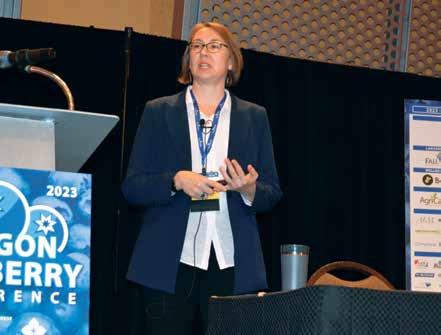
Part of OFS’s new outreach strategy is to participate in more agriculture and forestry conferences. Here OFS Executive Director Katie Murray talks to blueberry growers at the annual Oregon Blueberry Conference in February.
“We help encourage these different natural resource groups to come together to be visible in the community,” Monroe said. “We are trying to get agriculture, forestry and fisheries in the same room to talk about issues that are impacting them or their operations and create proactive opportunities to engage people on the front end. So, have relationships with their city council members, with their county commissioners, with the school board, with workforce development in their community, with the local police, with everyone to show them how natural resources is the thread of the economy of communities.”
Annual Meeting
As part of its outreach, OFS also launched its first annual meeting last year, hoping to bring together the different natural resource industries it represents into one room. And, Monroe said, the venture was a resounding success.
“Where else,” Monroe asked, “can you meet a blueberry producer, a cattle producer, a state agency
20 Oregon Seed Magazine

director, an OSU scientist, a forester and a product developer all in the same room? It’s just so special.”
“I just love the idea of giving people the opportunity to show up and connect with each other,” Murray said.
Also, Murray said, the annual meeting provides a great opportunity for its members to connect with state officials. “You can get agency people there. You can get university people there. And you kind of have an opportunity for people to see who your members are and what issues you have.”
Looking forward, Murray said she hopes to continue with the annual meeting, increase OFS participation in different commodity group meetings and expand what OFS offers its members.
“I would like to grow OFS,” Murray said. “And I’d like to play some role in stewardship programs and I think some of our members want us to be doing that, especially the registrants. They have big goals for stewardship and when they look at programs in Oregon, where there used to be a lot of education happening, those are fading away and there are concerns about who is going to be doing that.
“We have a lot of ideas and hopes for the future of OFS,” Murray said. “I really think that this organization is going to be very critical as we move forward, ten, twenty years from now. A lot of people may get some wake-up calls about the importance of tools and I hope that we’re still here to play a critical role in trying to stick to science and data and evidence on these topics.” F
Sameas: SelectMax®
Sameas: Calisto®& Explorer®
Sameas: Gramoxone®
Sameas: Quadris®
Sameas: QuiltXcel®
Sameas: Tilt®
Sameas: APOGEE/KUDOS®
With over 30 years in the crop protection industry we bring solutions for the value conscience growers throughout the US.
SPRING 2023 21
Matt Heinze VP Sales & Marketing matth@axill-solutions.net 559-936-0444 MOBILE www.Axill-Solutions.net
# Restricted use product. All product names, logos, brand names, or trademarks are property of their respective owners. All company, product and service names used in this material are for identification purposes only. Use of these names, logos, brands and trademarks does not imply endorsement. Products may not be registered for purchase in all states. Please check with your Axill Solutions Sales Manager. Product Name Pack Size Active Ingredient % Active HERBICIDES Clethodim 2EC 2x2.5 gal. Clethodim 26.40% 265 gal. Clethodim 26.40% Mesotrione 4SC 2x2.5 gal Mesotrione 40% Paraquat 3SL* 265 gal. Paraquat 43.20%
Azoxy 2SC 2x2.5 gal. Azoxystrobin 22.90% 265 gal. Azoxystrobin 22.90% AzoxyProp SE 2x2.5 gal. Azoxy/Propicon 13.5%/11.7% 265 gal. Azoxy/Propicon 13.5%/11.7% Propicon EC 2x2.5 gal. Propiconazole 40.3% PGR’s Pro Hex 27.5% WDG 4x5 lbs. Prohexadione Ca 27.50%
FUNGICIDES
Chuinard to Succeed Beyer at Seed Council
The Oregon Seed Council has named Megan Chuinard as its next Executive Director. She replaces Roger Beyer, who is retiring after 15 years with the Council on June 30.
Chuinard, 35, has spent the past twelve years working in and around the Oregon Capitol, including as a Chief of Staff for former Rep. John Davis, R-Wilsonville; as a policy analyst and legislative director for the Senate Republican Caucus; as a director of government affairs for Oregon Business and Industry Association; and most recently in public affairs for the Association of Oregon Counties.
“She has all the qualifications and the experience that we are looking for,” said Beyer, who worked with the Oregon Seed Council’s search committee in selecting Chuinard. “She has worked in the legislative process as a staff person. She’s been a lobbyist. She’s run campaigns. And she’s worked in associations.”
I think she has the potential to become the baton carrier for the industry for years to come.”
Roger Beyer
“We are very fortunate to be hiring someone of her caliber,” said Seed Council President Becky Berger. “Megan has a lot of experience in the areas that we need. I’m confident that those who work within and outside of our industry will welcome her passion and skills. She will be a formidable advocate for the seed industry.”
Chuinard said her initial plans are to visit with members to learn more about their issues, both on the regulatory and legislative side of the equation and on the day-to-day on-farm side.
“My aim is to really lean on the members for their expertise in what they’re facing,” she said. “And I think it will be important to look forward, to see what adaptations of legislation are coming and how that will affect growers.

“And then I think it is important that folks understand who we are and what we are doing. I see an opportunity to articulate to the general public what our seed growers are doing around issues like carbon sequestration and helping the state’s economy,” she said.
Chuinard has a bachelor of arts degree in political science with a minor in communications from the University of Oregon.
 Megan Chuinard at the Capitol in Salem is replacing Roger Beyer as executive director of the Oregon Seed Council.
Megan Chuinard at the Capitol in Salem is replacing Roger Beyer as executive director of the Oregon Seed Council.
She has limited experience in grass seed, but has worked fairly extensively on natural resource issues, both while serving the Senate Republican Caucus in the Oregon Legislature and, to a lesser degree, in an initiative petition campaign to repeal the state’s estate tax in 2012, during which she met with several seed growers to hear about the affect of the tax on their farms.
“She has a background in natural resources through her work in the Capitol and she is a native Oregonian, having grown up in the Forest Grove area amongst grass seed growers,” Beyer said. “So, I think she’s going to be a natural fit.
“I think she has the potential to become the baton carrier for the industry for years to come,” he added.
“I believe Megan will do an excellent job as the new executive director,” Berger said.
Chuinard said she was grateful for the opportunity to serve the industry and was looking forward to getting started.
“This is a really unique opportunity for me, for which I am grateful for, and I see an opportunity to use my strengths in lobbying, the legislative relationships I’ve established and my experience in association management and public relations to help elevate the industry,” she said.
Chuinard started May 8 and will take over sole responsibilities of the executive director position on July 1. F

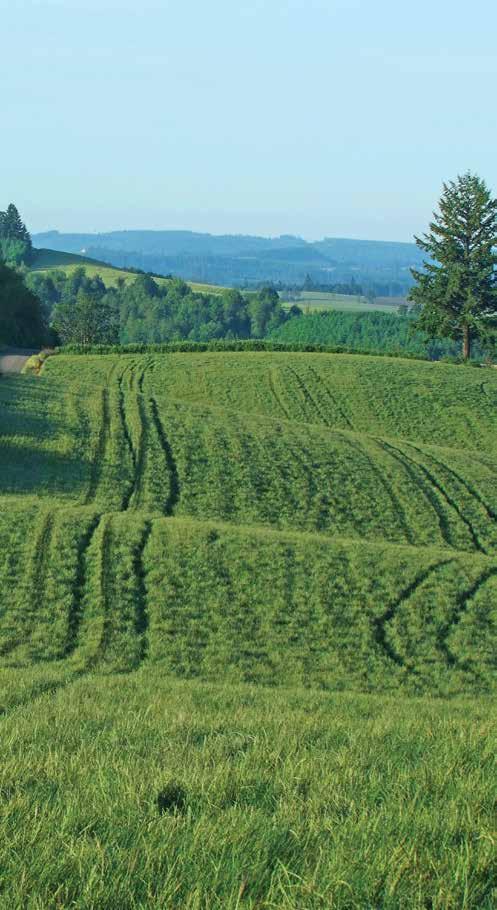
















FOR MORE INFORMATION: www.fmcagus.com Seed Crop Solutions Armyworms, Cutworms & Sod Webworms Can’t Hide From VANTACOR


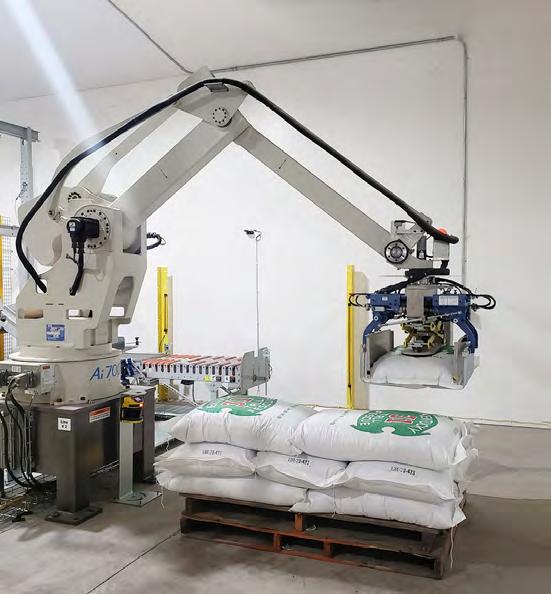




Blocking and Bracing: ‘An Important Issue’
Kate Hartnell, chair of the Oregon Seed Association’s (OSA) Associates Committee, noticed while working with grower warehouses that some had no formal training in blocking and bracing.
“And that concerned me because of the liability involved if the load were to cause an accident,” said Hartnell, president of operations for Saddle Butte Ag in Tangent.
Hartnell addressed the issue by bringing Jim Anderton of Mode Transportation to the OSA’s Annual Workshop.
Anderton, with over three decades of experience in transportation, took the opportunity to walk workshop participants through some of the blocking and bracing requirements for rail shipments and some of the repercussions for failing to properly secure loads. And later, Anderton, along with Sean Knowles, owner of the Albany Box Company, which offers a full line of blocking and bracing materials, and Braden Anderton sat down with Oregon Seed Magazine for a discussion on the topic.
Blocking and bracing intermodal container loads is important for several reasons, Jim Anderton said, including because the ramifications of failing to do so can be expensive, both in terms of liability and because a railroad at times will reconfigure a load that is not properly secured at a significant cost to the shipper. Also, according to Braden Anderton, loads that are not properly secured will shift during transportation and can arrive damaged at their destination, which can tarnish customer relations for seed companies.
Also, Jim Anderton pointed out, there are regulations and accompanying fines for improperly securing a load.
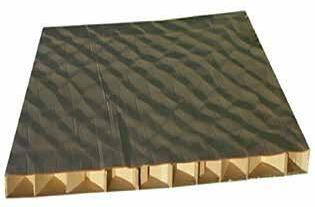
Core cell pads can be used as a solid filler between pallets when blocking and bracing intermodal container loads.
The issue of improperly securing loads has a long history in transportation, Jim Anderton said, and it recently escalated in importance. “It got pretty heated two or three years ago,” he said. “At one point, Union Pacific actually started pulling units off trains and reworking loads and charging shippers a $4,000 penalty for doing so.
“That’s another reason you want to block and brace these things,” Anderton said, “because a railroad during certain times of year will actually break the seal of a unit and open the doors to see if there’s blocking and bracing. And if not, you can either have them do it on site, which will cost you $1,000 or so, or you can take it back to your facility, block and brace it and then bring it back, which also incurs additional costs.”
At a minimum, intermodal container loads need to meet blocking and bracing standards, which were set by the Association of American Railroads (AAR) in conjunction with railroads. The standards,
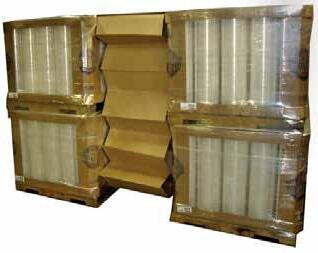
Corrugate drop filler can be used to fill voids between pallets when blocking and bracing a load.
according to AAR’s website, are designed to keep intermodal container shipping safe and to prevent damage to goods while in transit by preventing loads from moving side to side or forward and backward within a container or trailer during transportation.
Failing to meet the standards will ensure that railroads will not pay out liability costs in cases where goods are damaged during transportation, particularly given that railroads are self-insured, Jim Anderton said.
“If you don’t block and brace to the specification of the American Association of Railroads and you have a unit that blows up and you put in a claim, your claim will be denied because you didn’t block and brace,” Anderton said.
The standards, while definitive in certain respects, can be met in several ways, according to Knowles. The

key is to keep loads from moving by filling voids between pallets.
“It comes down to what your facility is set up for, what you have done in the past and what you are comfortable with,” Knowles said. “There is no one size fits all.
“As long as your load stays tight, you’re good,” Knowles said. “But anytime you get an unfilled void, then a load can start moving and once it starts, you can get a domino effect, which can lead to axle overweight.”
“What happens on a train is, as it is swaying, if it is not blocked and braced, cargo will start
Air bags are commonly used to fill voids when blocking and bracing container loads.
(continued on page 28)
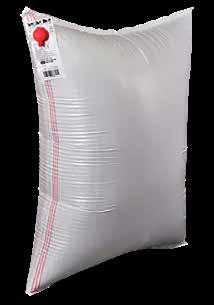

• Laser Controlled, Surface and Subsurface Drainage • Excavating and Site Preparation • Ponds and Ditching • GPS Mapping 541-740-5957 P.O. Box 235 • 33011 Garden Ln Tangent, Oregon 97389
(continued from page 27)


moving down the deck,” Jim Anderton said. “It just starts moving back and forth and before you know it the load just blows up. That’s what can happen if you don’t do any blocking and bracing.”
Knowles noted that in most industries, such as canned goods and lumber, loading has become standardized. That’s not so in grass seed, he said.
“It is one of the most difficult ones we encounter because so many different facilities do it differently,” he said.
Voids between pallets can be filled through several methods, including with use of air bags or corrugated blocking sheets, Jim Anderton said. “There are different products out there that meet the needs,” he said.
“You put the material down the middle of the load and that just pulls the whole load together,” he said. “It pushes the product to the outside, so when it starts swaying, it just holds everything in place. And then you get that bracing on the back end and another
two-by-four on top so the pallet can’t come over the top and you’re in good shape.
“The objective is always to make it so it is one big block, so it doesn’t blow up on you,” Jim Anderton said.
Properly blocking and bracing a load doesn’t have to be expensive, Jim Anderton added, and can be done efficiently after learning how to do so. Anderton and Knowles said that they would be happy to explain blocking and bracing to grower groups or will even drive to a grower warehouse if asked to do so.
“It is an important issue,” Anderton said, “and something these warehouses need to be aware of. If I have to come down and show someone how to block and brace, I have no problem doing that.”
The issue isn’t the 4,000 loads that are transported without issues, said Braden Anderton, who noted that most loads are properly blocked and braced. It’s the one load that isn’t.
“Then you will wish you would have taken the time to do it properly,” he said.
For more information, contact Jim Anderton at jim.anderton@modetransportation.com or call 503689-5433. Contact Braden Anderton at 503-869-2084 or by email at braden.anderton@modetransportation. com. Contact Sean Knowles at 541-926-4323 or by email at seank@abcbox.net. F
 Braden and Jim Anderton of Mode Transportation.
A general load diagram with double drop void fillers provided by Albany Box Company.
Braden and Jim Anderton of Mode Transportation.
A general load diagram with double drop void fillers provided by Albany Box Company.
IT’S WHAT YOU DON’T SEE THAT COSTS YOU.
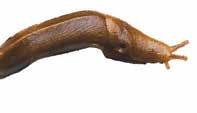

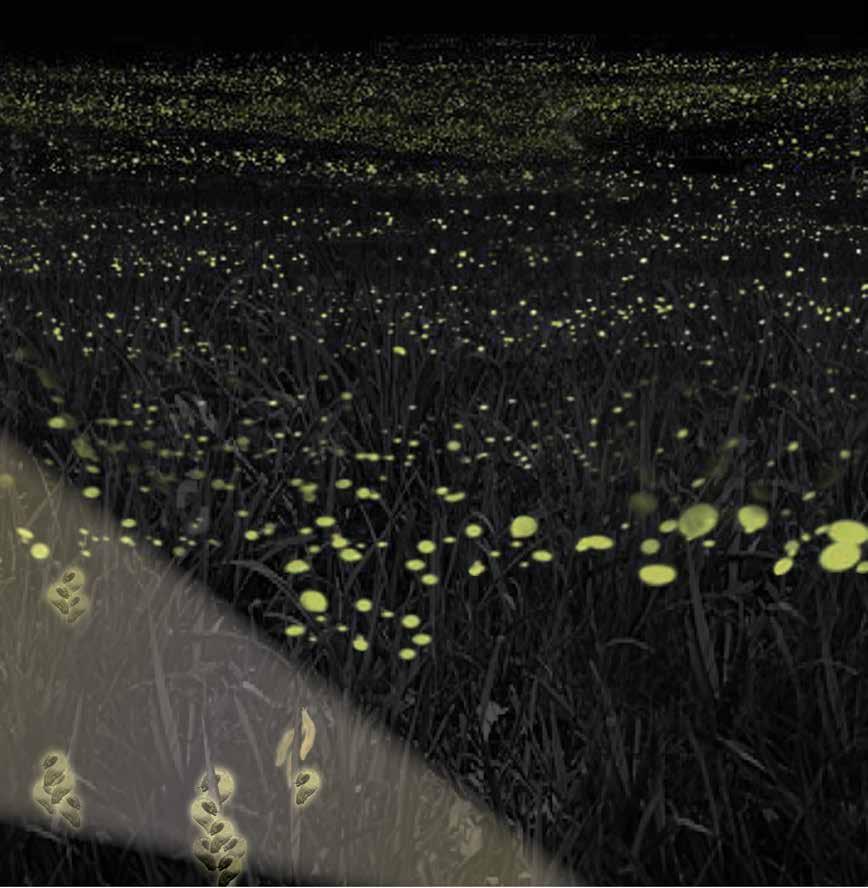
Spring brings an invasion of harvesting slugs that causes up to $100 million annually in damage to the grass seed market in the Willamette Valley.* Each night up to 30 slugs can cover each crown. Avoid sluggish grass seed yields with Deadline® M-Ps™ Mini-Pellets from AMVAC.
*Source: Oregon Seed Council
Contact Donnie Blades at 503-509-9776 or donnieb@amvac.com.
For more product information go to the Deadline M-Ps page at www.amvac.com.
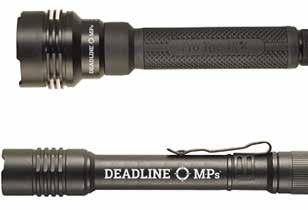
Always read and follow all label directions and use precautions. AMVAC and Deadline MP are trademarks owned by the AMVAC group. ©2022 AMVAC Chemical Corp. is a wholly owned subsidiary of American Vanguard Corp. All rights reserved.
AMVAC.com
Northwest States Harmonize Sod Quality Standards
The Oregon seed industry, with cooperation from Idaho and Washington, is in the process of harmonizing sod quality tag standards that for years have been varied between the three states.
The new standards, which are expected to be approved this summer, include changes in purity standards, germination standards and sample sizes.
The harmonization was proposed by the Oregon Seed Association.
The new rules will harmonize sample sizes between the three states at 50-gram sample sizes of perennial ryegrass and tall fescue sod; 25-gram sizes for Kentucky bluegrass; 30-gram sample sizes of red and Chewings fescue; and 20-gram sample sizes of hard fescue, sheep fescue and blue fescue.
Currently, Oregon and Washington require 50gram samples of perennial ryegrass and tall fescue, while Idaho’s standards called for 25 grams. Sample size requirements for Chewings and red fescues are different across the board, with Oregon requiring 30-gram sample sizes, Washington requiring 50-gram sample sizes and Idaho requiring 25 grams.
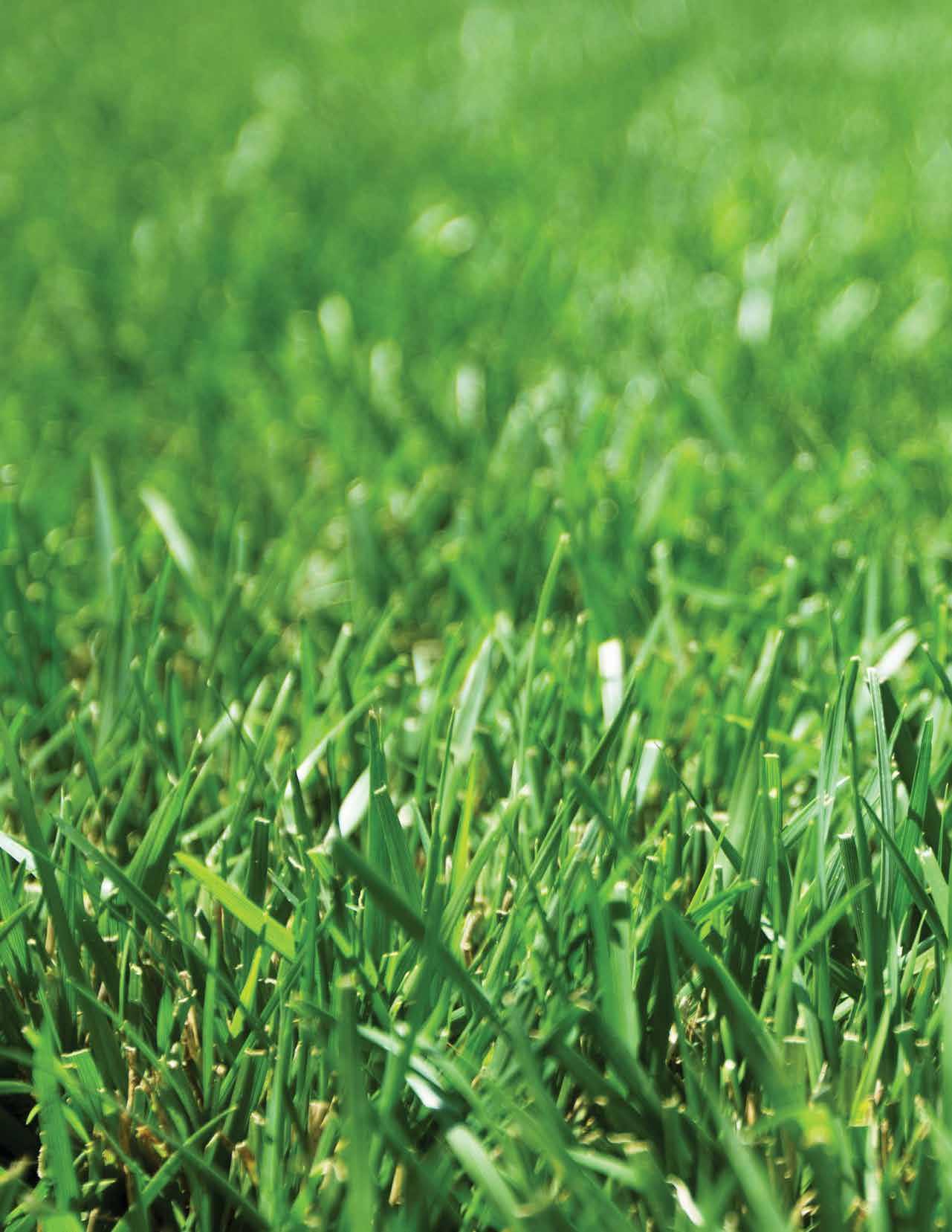
The new standards also would lower the minimum germination percentage for red fescue and Chewings fescue sod from 90 percent to 85 percent, as well as lower the minimum purity standards for perennial ryegrass sod from 98.5 percent to 98 percent, aligning the standards with Washington’s current purity standards for perennial ryegrass sod.
The proposal leaves in place other current purity and germination standards for sod quality, including a minimum purity of 98 percent for perennial ryegrass, minimum germination of 90 percent for perennial ryegrass, 85 percent for tall fescue and a maximum weed percentage of 0.02 for perennial ryegrass and tall fescue.
Another change involves moving the printing of sod quality tags in Oregon from the Oregon Department of Agriculture to Oregon State University.
“Our intent is to fully transition the Oregon printing to OSU by July 1,” said Elizabeth Savory, manager for the ODA Plant Health, Seed Regulatory and Smoke Management programs. F



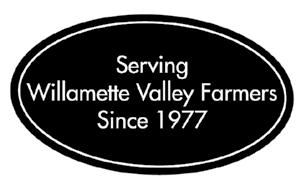

Perennial Ryegrass Assessment Mechanism Changed
The Oregon Ryegrass Commission has changed the assessment mechanism for perennial ryegrass from a volume basis to a value basis.
Starting July 1, growers will be assessed 0.35 percent of the sales price for perennial ryegrass seed. Annual ryegrass seed and intermediates will continue to be assessed at a rate of 15 cents per hundredweight.
The Commission voted for the change in September but wanted to implement it until July 1 at the request of some in teh industry.
“We quite frankly had a run on seed and very strong sales, and we have a moment of time where the industry is really looking at some fairly significant issues that we need to address with research,” said Commission Administrator Bryan Ostlund.
Under Oregon statute, agricultural commissions can use revenue generated from assessments for research, promotion or educational purposes.
The change is expected to bring added revenue to the Commission, but just how much additional revenue remains to be seen.

“Everything is a moving target,” Ostlund said. “When we first started discussing this in 2022, based on movement at that time, it would have generated an additional $200,000. But we saw things slow through the fall months.”
The change brings the assessment mechanism for perennial ryegrass on par with how turf-type tall fescue is assessed. F

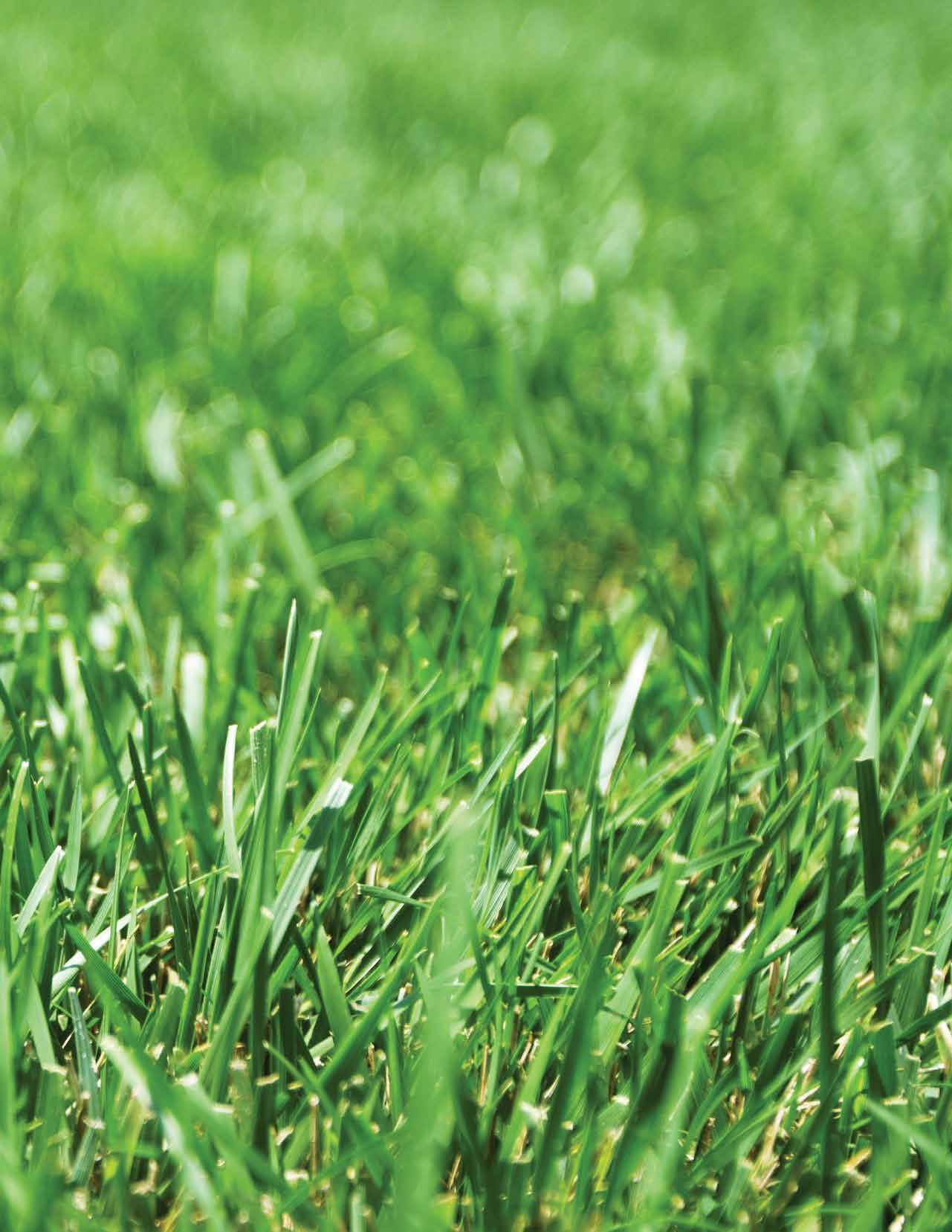

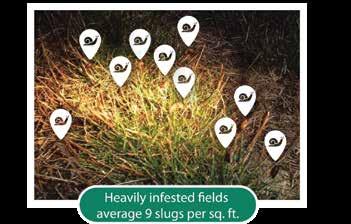
Call today for more information about LOCK OUT®. 541-926-1200 SLUGS CAUSE $70-100 MILLION DAMAGE TO THE GRASS SEED INDUSTRY PER YEAR An ounce of Prevention Today is Key to Saving Your Investment. WilburEllisAgribusiness.com For information only. Not a label. Prior to use, always read and follow the product label directions. Wilbur-Ellis logo and LOCK OUT are registered trademarks, and MOLLUSCICIDE logo is a trademark of Wilbur-Ellis Company LLC. The Winning Ag Experience. WHY LOCK OUT ® ? • Superior attractant package • Pellet will not mold • Pellet will not break down • Excellent field visibility • Uniform pellet size for even application • Extensive research and development POWERED BY Heavily infested fields average 9 slugs per sq. ft.
New Wave of Scientists Bear Promise for Oregon Seed Research
When Oregon State University Extension Seed Production Specialist Nicole Anderson was hired 14 years ago as a North Willamette Valley field crops Extension agent, she was part of what she described as a “changing of the guard” of seed researchers.
Today, Anderson said, the industry is experiencing a second “changing of the guard,” with several scientists recently joining seed research programs at the USDA’s Forage Seed and Cereal Research Unit and OSU’s Department of Crop and Soil Science.
“Between the two institutions, I think this is the start of the next generation of seed research,” Anderson said. “There is definitely a changing of the guard happening right now.”
Central to this latest development is that nearly all the newly hired scientists are what Anderson and ARS Forage Seed and Cereal Research Unit Leader Ryan Hayes characterize as “early-career scientists,” a category of researcher that typically has fresh perspectives and knowledge of the latest in technological developments.
“They bring in a lot of new ideas, fresh perspectives, energy and enthusiasm,” Anderson said. “They also bring in new skill sets because they’ve been more recently trained. And a lot of times they come from areas outside of Oregon where they’ve been taught skill sets that they may be able to apply here. Or they’ve been trained in new technologies and new scientific methods that maybe weren’t around when some of the earlier career scientists were getting trained as graduate students and postdocs. And they typically come in with a new, fresh perspective on things that we’ve maybe battled for a long time.”
“The other thing is, early-career scientists want to establish themselves to create some sort of stability for their career, so their productivity is really high,” said Hayes, who recently brought on five early-career scientists into the ARS research unit.
Hayes added that he has been thrilled to see the level of research the new scientists are bringing to the table and the novel way they are approaching longstanding issues in seed production.
“All the newest techniques are getting applied to seed crops right now,” Hayes said, “whether that is entomology, ecology, soil science, weed management. All of these new hires are bringing the latest and greatest into our research.”
The real beneficiaries of this new wave of researchers, according to grass seed commission administrator Bryan Ostlund, are Oregon growers.
“It is all pretty exciting and encouraging for our future,” Ostlund said.
Long-Term Benefits
In some cases, the benefits brought by these early-career scientists may not appear right away, according to sources. But long-term, the promise for improvements in crop management are substantial.

Plant Pathologist
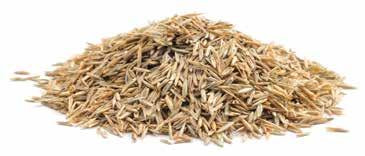
At the winter OSU Extension Seed and Cereal Crop Production meetings, Hannah Rivedal, a plant pathologist who joined the ARS research unit in 2021, aired plans to develop a riskassessment decision aid for the barley yellow dwarf virus in seed production systems to help growers stay ahead of the disease curve. “And from there, we want to consider what sort of environmentally controlled factors and what sort of grower-control factors we can manipulate to impact disease incidence and severity,” Rivedal said.
Hannah Rivedal joined the ARS Forage Seed and Cereal Crop Research Unit in 2021.
Clint Mattox, a weed scientist who joined the ARS unit last year, said he is looking at a novel approach to long-standing efforts to control annual bluegrass in grass seed
(continued on page 34)
SPRING 2023 33
(continued from page 33)
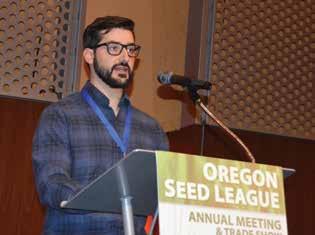
New Geneticist and Molecular Biologist
Dustin Herb, a research geneticist brought on by the ARS unit in February, said he intends to use the latest methods in genetics to release advanced breeding germplasm for private breeders to utilize and develop some public varieties as well.
“From day one, he just came right out of the gates doing the things that we need to do and bringing some expertise that we don’t have,” Hayes said.
Joe Gallagher, a molecular biologist, joined the ARS unit in January from a postdoctoral program at the University of Massachusetts in Amherst with hopes of working closely with Herb and other breeders to bring advance traits to seed cultivars.
production systems. “Because annual bluegrass biology is so complex and so capable of developing resistance, I want to focus my program not so much on finding the herbicide that is going to work, but on looking at more cultural practices, more ways of thinking about the system in general,” Mattox said. “I want to focus on how to manage the grass seed field in order to avoid annual bluegrass getting into our crop, getting into our combine and just reducing the population in general.”
Seth Dorman, an entomologist brought on by the ARS unit last year, is working to provide Oregon seed growers spatial and temporal patterns of pest populations across grass seed production areas in Oregon.
Dorman and others involved in the project have developed GIS apps that enable them to collect and send pest data to an online platform to share with the industry (https://oregonpests-usdaars.hub.arcgis. com). “This allows us to share what we are finding in commercial fields in real-time with growers and crop consultants to help inform crucial monitoring windows for priority pests in our production systems,” Dorman said.
He added that the team involved with the project plans to expand the platform in coming years “to share pest alerts and summary data of pest monitoring efforts throughout the growing season for economic pests in our major commodities across the Valley, in addition to risk-forecast tools as they are developed in collaboration with participating OSU and USDA researchers and the Oregon IPM Center.”
“My overall goal is to evaluate the genetic and genomic diversity within forage and turfgrasses and connect that diversity to specific traits that are important either for seed production or for end use,” Gallagher said. “And as a part of that, I’m planning to use molecular-biology tools to get deeper on how these diverse genes are affecting traits that we care about and determine what other genes might be interacting with them.
“That work will be something that I can share with breeders for improving the grasses,” he said.
New Weed Scientist
OSU Weed Scientist Pete Berry, an early-career scientist who started at OSU in September after a four-year stint working for Syngenta in the Midwest, is interested in bringing precision ag technology being used in Midwest corn and soybean systems into weed control programs for Oregon seed production.
“Pete has the potential to take the weed science research in a different direction than where it’s historically been,” Anderson said. “And he is bringing in background both from his training in precision agriculture and his background of working in the private industry for Syngenta.
“You don’t always have that luxury of bringing somebody from private industry back to academia,” Anderson added. “Usually, it goes the other way around. So, I think he brings in a unique perspective.
“Also, we are fortunate to be able to bring somebody back that has that history here (Berry got his Ph.D. at OSU) and that wanted to come back here and stay long term,” she said.
A big part of why the seed industry has this new level of support in research can be traced to the work of Hayes and Staci Simonich, Dean of
34 Oregon Seed Magazine
ARS Entomologist Seth Dorman at the Oregon Seed Growers League meeting in December, is working to provide Oregon seed growers spatial and temporal patterns of pest populations across grass seed production areas in Oregon.
the College of Agricultural Sciences at OSU, said Ostlund, administrator of three Oregon grass seed commissions and the Oregon Clover Commission.
“Ryan (Hayes) came in during a low period of support for ARS’s unit in Corvallis, when that unit was literally on the chopping block. And then with some help from the industry to lobby ARS leadership and let them know that we support that unit, Ryan has turned that whole thing around a full 180 degrees,” Ostlund said. “He has had a pretty impressive string of hiring at the unit and within all manner of disciplines.
“We just couldn’t be more complimentary of his efforts. It’s kind of like the Phoenix rising from the ashes to where he’s at today,” Ostlund said.
“And then on the Oregon State University side, we’ve seen a new dean come in and Staci Simonich has taken a serious look at kind of where the Crop and Soil Science Department is, what kind of holes there are in the program with the loss of some people recently like Caio Brunharo and Andy Hulting. And she’s done a nice job of coming back in with strong commitments to put people back in the right places, to expand some programs, what with Nicole Anderson moving to campus with her statewide position and the creation of a new position in precision agriculture (which is in the hiring process).
“And Pete Berry, who is filling Caio Brunharo’s old position, has a strong background in precision ag as well. So, it is kind of shifting of the traditional focus into new and innovative programs,” Ostlund said.
“And now just looking at what technology exists out there, some pretty sophisticated
A.I. that we’ve seen out of California and other places, plus all the major manufacturers that service the huge part of U.S. agriculture, wheat, corn and soybean, and bringing some of those technologies into the smaller specialty crops like grass seed, it is all pretty exciting and very encouraging for our future,” Ostlund said.














Why choose from an assortment of tools when one will do the job? Liphatech is essential for any pest control toolbox—Metarex for slugs & snails, Rozol* for voles & pocket gophers and FastDraw for rats & mice around barns. For pests that come your way, rely on one single source. Liphatech—Totally Equipped.
SPRING 2023 35
F
MULTIPLE SOLUTIONS * Restricted Use Pesticide; see the product labels for use sites and restrictions. liphatech.com • 888-331-7900
Seed Industry Loses Two Stalwarts
The Oregon seed industry lost two stalwarts in the latter part of last year with Clarence Dwight Venell passing away on September 17 at the age of 95 and Charlie Kizer passing away on December 23 at the age of 97.
Both farmed in the South Willamette Valley, with Venell growing grass seed just south of Corvallis and Kizer farming just east of Harrisburg.
Charlie Kizer
Kizer, who was the third generation to farm the Kizer family farm, was a member of the Oregon Ryegrass Commission in the early days of the Commission and won the Oregon Seed Council’s Seedsman of the Year award in 1967. He also worked on trying to start a marketing order, an effort that four or five iterations later resulted in the formation of the Perennial Ryegrass Bargaining Association and subsequently the Oregon Grass Seed Bargaining Association.
In the 1960s, as a member of the seed commission, Kizer travelled to Texas with other commissioners to check out a new annual ryegrass cultivar, Gulf, a variety still widely grown today.
Kizer also was on the front lines of the field burning controversy. At one point in the late 1960s, the local Eugene newspaper printed the family’s home phone number with the message that if people had a complaint or a problem with field burning, they should call the number.
“He spent a lot of time on the phone during that summer, talking with people about field burning,” said Kizer’s son, Wayne. “He tried to make the best out of it that he could.”
Kizer retired from farming in 1990 at the age of 65. “He traded in the combine for a motor home,” Wayne Kizer said. “He did a good job of letting me run the show the way I wanted to. I’ve tried to do that now in my life and I’m realizing the grace and trust that it took to do so.”
In retirement, Kizer was involved in Harrisburg Area Museum, also known as Heritage Park.


“He wrote several articles comparing the farm equipment they have in the museum to what we have today,” Wayne Kizer said.
At the age of 93, Kizer served as webmaster for the museum. “I guess that made him one of the oldest webmasters,” Wayne Kizer said. “He was never afraid of technology.”
Charlie Kizer explains to his office manager’s son Jessie Knox how to determine the ripeness of annual ryegrass in this 2018 photo.
Venell came to the South Valley from Nebraska with his parents via train and an immigrant car in 1941, according to his obituary. His parents were farmers in Nebraska and Venell started farming on his own while still in high school, renting 40 acres from his parents.
He had expanded that to 150 acres by the time he graduated from Corvallis High School in 1945, and he continued to expand the operation from there, purchasing his first 340 acres in 1957, the same year he married Rosetta Claudine Brandt.
That acreage became their home place and the start of his and Rosetta’s lifelong farming operation.
In addition to his dedication to agriculture, Venell was an avid pilot. He earned his pilot’s license at age 18 and logged over 10,000 hours of flight time, often taking his family for extended weekends to Yellowstone, Grand Tetons, South Dakota, Arizona, New Mexico, Canada and other destinations. He would also monitor his fields from the air in his 1956 Piper Super Cub.
INVESTING IN OUR AG COMMUNITIES FOR 65 YEARS
Banking with a Local Focus:
• On-site Loan Officers who are empowered to make local loan decisions, offering a variety of ag operating lines of credit and equipment & real estate term loans.
• Access to modern banking technology supported by personalized care you expect from a community bank.

www.citizensEbank.com
15 Branches across 13 communities in the Willamette Valley
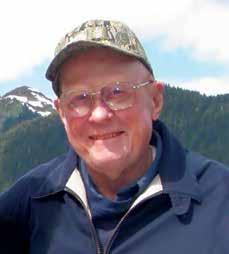
Venell is survived by his wife, Rosetta; son
Larry (Pam); and daughter Beverlee Stilwell (Jerry); as well as four grandchildren and seven greatgrandchildren. F

37
Clarence Dwight Venell
Clarence Dwight Venell
Member FDIC
Growers Work to Avoid Build-up of Resistant Weeds
Loran Steinlage of Folio Farms in West Union, Iowa, isn’t battling glyphosate resistant weeds on his farm. But in an area where Roundup-resistant crops dominate the landscape, he is the exception. “I personally don’t have issues with resistance, but it is all around me,” Steinlage said.
More than two decades of spraying glyphosate over the top of Roundup Ready soybeans and corn have compounded issues of glyphosate-resistant weeds in the Midwest. And, according to Oregon seed grower Nick Bowers, who sold seed often to Steinlage over the years, the issue is not isolated to the Midwest.
Bowers said he cringes each year at the National No-Till Conference when he sees a sales representative from an ag chemical company display a map to a roomful of growers showing where glyphosate resistant ryegrass is present in the U.S.
“They put this big map on the screen that shows they found Roundup resistant ryegrass in 48 states or something,” Bowers said. “Oregon producers need to do their part so that we don’t create more resistant annual ryegrass and people feel comfortable to buy our product and use it in other states.”

It is too late to keep Oregon off that map, Bowers noted, given that glyphosate resistance in annual ryegrass has shown up in hazelnut orchards and other sites in Oregon. But Bowers believes that adopting measures that minimize the spread of glyphosate resistance in Oregon is critical to ensuring Oregon seed growers continue to have the tools necessary to grow quality grass seed at an affordable price.
“You don’t want to lose glyphosate as a tool,” Bowers said. “You don’t want to get to the point
where some of these guys are in the Midwest, where they have these Roundup resistant weeds.”
Modes of Action
One reason herbicide resistance presents such a threat to agriculture, according to Carol MallorySmith, an emeritus weed science professor at Oregon State University, is because of the finite number of herbicide modes of action available for growers and because new modes of action are not emerging at the rate they once did.
“In the past, some of the older growers would expect that every few years we are going to get a new herbicide and they are going to get a new mode of action,” MallorySmith said. “A lot of the younger farmers have not seen that pipeline of new products coming in.”
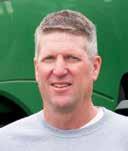
The result, she said, is an increased awareness of resistance. Still, she said, resistance is as big a problem today as it was when she started at OSU, 25 years ago. And the shelf life of new chemistries is being cut short.
“The problem is, every new product that we’ve gotten has been put into too many crops and been overused,” she said.
“When we got Zidua, for example, it was more of a wheat product,” she said. “But then we figured out we could use it in grass seed and we could use it in other crops. So now Zidua is being used across all rotational crops. And now people are talking about Zidua resistance.
“I think farmers should think about, especially if they get a new mode of action, how to preserve the new herbicide,” Mallory-Smith said. “Instead of using it in every single crop you grow, decide what is the worst weed you want to control and where do you want to use that product.
38 Oregon Seed Magazine
Nick Bowers
Loran Steinlage
“Pick the crop where you need the most control and the weed that is going to cause the most problems and actually think about limiting its use,” she said.
“And don’t move those resistant weeds around. If you know you have a problem field, leave it for last to harvest or clean your equipment after working it,” she said. “Yes, it takes a lot of time to clean equipment, it is a lot of work and when you are harvesting, you don’t have much time. But so is controlling that resistant weed forever in your next field.”
Altering use of herbicides from one year to the next also can help slow resistance, Mallory-Smith said, a strategy Bowers has adopted in recent years.
“I still use Roundup, but the last four or five years, I started using Gramoxone when I could just to mix it up and I also use Select in my rotations,” Bowers said.
“If we continue to use the same chemistries year after year, we could be heading for the same situation we are seeing in the Midwest,” he said.
Bowers said crop rotation is another key strategy for slowing the development of resistance. “I think crop rotation is very important if you have the opportunity,” Bowers said.
And tank mixing chemistries also has been shown to be effective in resistance management, according to MallorySmith.
is a little bit of protection there because of the use pattern,” she said.
Every Tool in the Toolbox
Steinlage, the Midwest grower, said he didn’t start growing glyphosate-resistant crops until well after most of his neighbors. By that time, he said, it became apparent that glyphosate resistant weeds were becoming an issue in corn and soybean rotations. So, Steinlage, who uses annual ryegrass as a cover crop in part to provide competition for weeds, has learned to limit his use of glyphosate.
We have never found resistant annual ryegrass in a
seed
lot. We have tested multiple times and we have never found resistance in our (commercial seed). And there is no reason to think that if they find resistance in the Midwest, especially glyphosate resistance, that it would have come from Oregon rather than from them selecting it themselves with the amount of glyphosate they use.”
“There is data to suggest that tank mixing might be a better idea than using different herbicides in sequential applications,” Mallory-Smith said. “The problem is, you have to find the right combination and that is extremely difficult because they have to have different modes of action, pretty much equal control on the same weed species you are trying to control and the same timing. It is really difficult to find that combination.”
Carol Mallory-Smith
“We used it on probably 25 percent of our acres this year,” he said. For example, Steinlage said he uses a grass herbicide to spray out his annual ryegrass cover crop rather than the less expensive broad spectrum glyphosate products. He’ll even use a roller-crimper at times to avoid using glyphosate. “We try to use every tool in our toolbox,” he said.
The resistance issues facing Oregon seed growers are really no different than those facing Midwest farmers, MallorySmith said, and no less significant.
“In some ways, we have a worse problem because of seed contamination,” she said. “They are dealing with the weeds as competition, which is a big problem, but they are not dealing with contamination in the crops they want to sell.”
To date, Mallory-Smith said, “We have never found resistant annual ryegrass in a seed lot. We have tested multiple times and we have never found resistance in our (commercial seed). And there is no reason to think that if they find resistance in the Midwest, especially glyphosate resistance, that it would have come from Oregon rather than from them selecting it themselves with the amount of glyphosate they use.
One good development in recent years has been the registration of the Bayer herbicide indaziflam, or Alion, in grasses grown for seed, a development which brought the industry its first new mode of action in 20-plus years.
“I think Alion resistance will be a few years out because of the way it is used, in that we can’t use it every year and we can’t use it in every crop, so there
“We assure our grass seed for germination and purity,” she added. “It is the same kind of thing.”
Still, the very existence of glyphosate-resistance annual ryegrass, be it in orchards or in other settings, is a bad look for the Oregon grass seed industry, Bowers said. And using rotations and mixing up chemistries in weed control programs will be key to ensuring Oregon growers have tools for controlling weeds for years to come. F
SPRING 2023 39
OSU Extension Report
Iwas raised on a farm in the little town of Forest in central Mississippi. My great-grandfather started this farm in 1918 and I’m proud to say today that I’m the co-owner of a century farm. It never left the family.
My father was a full-time farmer. When I was growing up, we grew fruits and vegetables and some cotton. I’m the fifth of eight children and we were all expected to help on the farm. The only day that we were allowed to rest was on Sunday, a sacred day for church and family.
On occasion, Extension agents from Mississippi State University would come out to our farm to talk to my father. I say “talk to” because they would mostly tell my father what he should be doing. It was all about telling, not collaborating. The minute they left, he would say, “Forget that.” In his mind there was no engagement.
My father’s words stuck with me through the years. After graduating from Alcorn State University, I was a county Extension leader for Mississippi State University for nine years. When I worked with farmers, I always listened. My feeling was – and still is – let’s do with, not do to. In Extension we are collaborators. We are co-creators.
That’s a little bit about me and my strong connection to farming and rural communities. Now, I’d like to share some of what I’ve learned in the 18
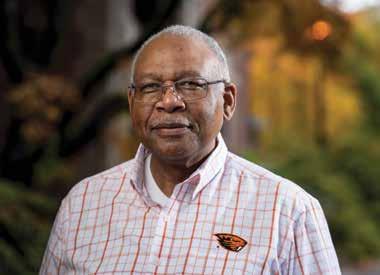
months I’ve been serving Oregon as Director of OSU Extension. I also want to share my vision for OSU Extension as we move forward. And I will touch on our current funding bill that is working its way through the Oregon Legislature.
Agriculture is essential to the vitality of our rural communities and our state, and that starts with supporting our farmers. Our collaborative research and educational efforts include:
• Partnering with the Oregon seed industry for more than 100 years through our OSU Seed Services, which include the Seed Lab and Extension seed certification program.
• Improving grass seed yields by using different swathers at harvest.
• Testing insecticide alternatives now that chlorpyrifos has been banned.
• Using dogs to detect voles to control their populations.
• Forming the Eastern Oregon Bluegrass Workgroup, which has led to the initiation of several research projects relevant to the industry.
40 Oregon Seed Magazine
OSU Extension Report
Ivory W. Lyles, Vice Provost for Extension and Engagement, Director of OSU Extension
Ivory W. Lyles, Vice Provost for Extension and Engagement and OSU Extension Director
A Division of G.A.W. Inc CCB #75124 (541) 912-5236 JASON PERROTT Agricultural Drainage Solutions Agricultural Drainage Solutions Agricultural Drainage Solutions
Photo credit: Oregon State University
• Launching virtual coffee hour meetings for Willamette Valley growers that addressed slug management, soil health and managing weeds.
I want to take a moment to recognize our work with the ag industry that goes beyond the crops, livestock and land. OSU Extension is helping address mental and behavioral health issues that we should be talking about more – including the fact that suicide rates are higher in rural communities and among people in agriculture, forestry, fishing and hunting industries. Our efforts include evidencebased mental health first aid and QPR (Question, Persuade, Refer) suicide prevention trainings. These trainings teach practical, lifesaving knowledge and skills that anyone can use. Mental health, especially for our young people and rural communities, is one of my personal priority areas.
Our 600-plus Extension employees work hard, day in and day out, to help Oregon thrive. But we can only do so much with the funding that we receive from the state. In recent legislative sessions we have not received the dollars that we’ve requested just to maintain our current staffing and service levels.
These shortfalls affect our ability to fill positions in areas of critical need. Our farmers and all Oregonians deserve better. That’s why, based on input from our stakeholders, we’ve asked for a significant increase in funding for the 2023-25 biennium. Our legislative request is critical for the communities we serve.
I love my job. I’m a positive person and I’m optimistic about the future. If OSU Extension is successful, our state will be successful. Our goal is to help people and change lives for the
better, not only for the current generation but for all generations to come.
If you or someone you know is struggling or in crisis, help is available. Call or text 988 or chat 988lifeline.org F KEN


At ISG, we recognize the importance of commitment and dedication to each of our growers. We take our time, experience and knowledge to help each grower make crop decisions to better their business. Give us a call today, our staff is always available for questions, concerns and advice from planting to harvest or from cleaning to sales.
503-932-8165
kpietrok@integratedseed.com FRANK
971-259-9134
ccox@integratedseed.com
SPRING 2023 41 OSU Extension Report
PIETROK
Field Representative
PRANTL Field Representative
541-570-9579
HARRIS Field Representative
COX
& Marketing
fprantl@integratedseed.com ROB
541-990-1138 rharris@integratedseed.com CRYSTAL
Sales
would like to thank all of our growers for their loyal
PARSONS Field Representative
ISG OFFICE
(fax) isgoffice@integratedseed.com
ISG
support! JIM
503-580-9425 jparsons@integratedseed.com
503-583-0466 888-246-9705
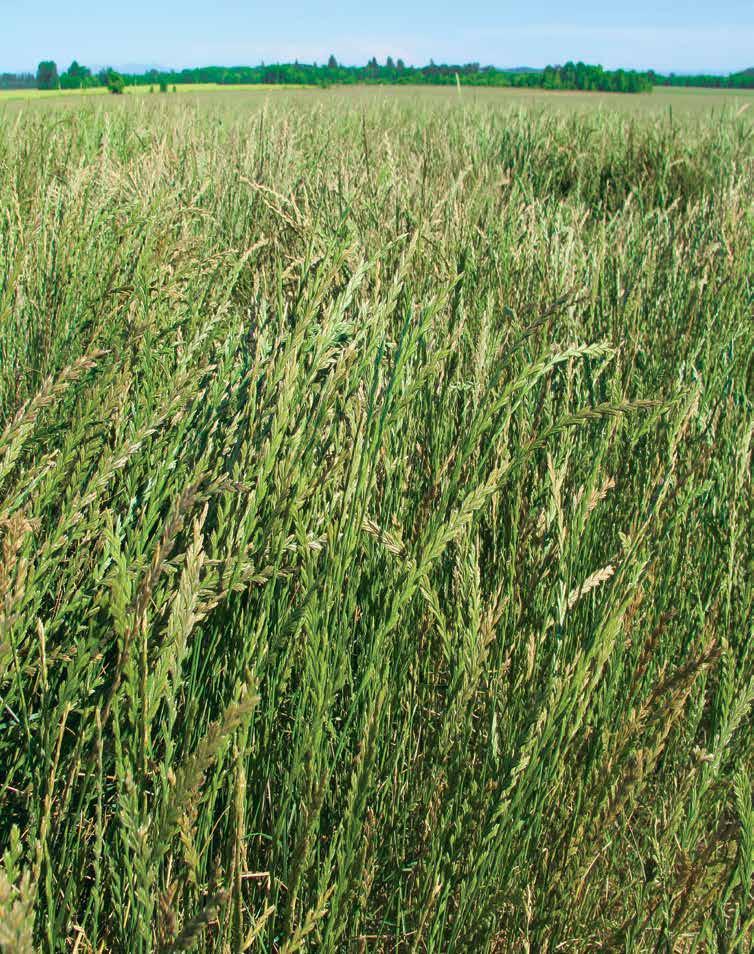
42 Oregon Seed Magazine ogsba.com OGSBA was formed by seed growers in 1994 to give growers an opportunity to negotiate fair prices with seed dealers. Oregon Growers’ Best Source for Information By Growers - For Growers For questions or to sign up for news briefs, contact: Mark Simmons • 503-551-3208 • marksimmons@ogsba.com

Seed Council Update
Roger Beyer, Executive Director, Oregon Seed Council
As I prepare this column, it is mid-April and I and other ag industry executives have just come from our first formal meeting with Governor Tina Kotek. I’m pleased to report that the meeting went well.
To point out a few highlights: Governor Kotek stressed the importance of collaboration and working with all groups, including the ag sector, which our group felt was a very positive sign, and she pledged that as she goes around the state visiting with different sectors that we in the ag sector be sure to invite her to meet with us and join us on tours and other events that might be of interest to her and her natural resources staff.
I think it is important that we take her up on that offer and regardless of whether or not she may turn us down a time or two that we continue to try and get her and her staff out to see production farms so they can learn more about our industry. Governor Kotek is going to be our governor for the next three-and-a-half years, so we need to make sure we have a good and positive working relationship with her and her team.
The Governor also pledged that as she and her search team look for our next state Director of Agriculture that we will have multiple opportunities to provide input. She informed us that they are looking at a September timeline to have that new person on board, so we should have time over the summer months to provide input as to who the next Director will be.
It was also good to hear the Governor stress the need to have agencies that are focused on customer service. And she said she recognized the importance of research to our sector, while noting that she felt her proposed budget will help meet that need. It was good, incidentally, to hear her specifically point out the importance of the Extension Service and the Ag Experiment Station to our industries. To that end, as the 2023 Legislative Session winds down, it will be
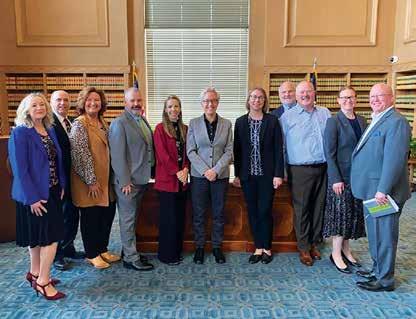
important that we work within the legislative process to help secure a positive budget for the ag sector.
Again, this was a very positive meeting and we look forward to working with Governor Kotek as she continues to go through her first term.
As a final thought for this column, I want to let you know that as my work with the Seed Council comes to a close and my retirement approaches, I am hoping to spend some time with the new Executive Director of the Oregon Seed Council to help him or her get up to speed on issues, so we can have a smooth transition and the industry will be well served moving forward. And I want to thank the industry once again for being so easy to work with and generous with your well wishes. F
SPRING 2023 43
Seed Council Update
Ag executives meet with Governor Tina Kotek, center, in the Oregon Capitol.

ICommissions Update
Bryan Ostlund, Administrator, Oregon Ryegrass, Tall Fescue, Fine Fescue and Clover Commissions
n my column this issue, I would like to thank leadership at both the USDA ARS Forage Seed and Cereal Research Unit and Oregon State University, and particularly College of Agricultural Sciences Dean Staci Simonich, for working with the industry on retooling the industry’s approach to its support for OSU and USDA research.
From my perspective, the approach worked very well for everybody involved. I’m sure it seemed like a long series of meetings for some, but all of them were meaningful and each built on the success of the previous meeting.
To backtrack, we started the year getting the industry together with researchers to discuss and eventually establish a set of research priorities that aligned with industry needs. Not surprising, the priorities were well aligned with previous years, but it’s valuable for the industry to conduct a periodic review to make sure researchers and growers are on the same page.
Following that process, the industry put out an RFP, or request for proposal, to all known
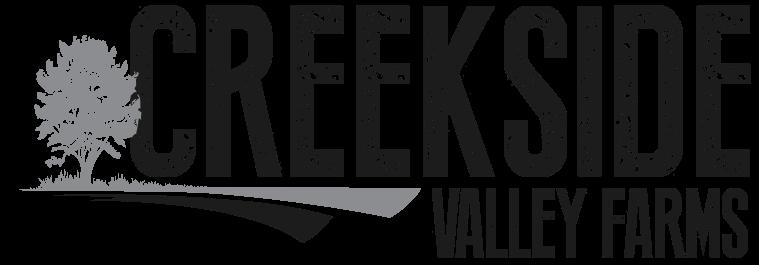
researchers, both here in Oregon and other places. We were pleased to get back twenty proposals from seventeen researchers representing slightly more than $600,000 in funding. And all of the proposals were strong.
Next, we set up a meeting for researchers to present their proposals to growers at a research roundup meeting, a process that gave commission members an opportunity to listen to proposal summaries and ask questions. For those of you unfamiliar with the Oregon Seed Research Institute (OSRI) Board, it is made up of grower representatives of the three Oregon grass seed commissions and the Oregon Clover Commission.
The OSRI Board then worked with me, Steve Salisbury, the industry’s research and regulatory coordinator, Ryan Hayes, research unit leader of the USDA ARS Forage Seed and Cereal Research Unit in Corvallis, and Tom Chastain, head of OSU’s Department of Crop and Soil Science, to determine which projects to fund, to what level and which commissions or commission, in some cases, would fund the projects.

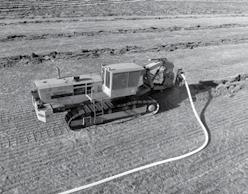




Commissions Update Installation, Consulting, Repairs & Maintenance. McDonald, Jefferson, Yamhill, Wepster, York, Eta, Theta & Felix. FARM DRAINAGE: HAZELNUT TREES: ADAM BAUMAN: 971-901-1665 • PAUL KUEHNE: 503- 437-4833 CALL TODAY FOR A QUOTE & AVAILABILITY
OSU Seed Services
OSU Seed Services
Seed Years
Partnering with Oregon’s Seed Industry for over 100 Years
Partnering with Oregon’s Seed Industry for over 100 Years
Seed Lab
Seed Certification | seedcert.oregonstate.edu
Seed Certification | seedcert.oregonstate.edu
n Accurate and Timely Results
• Maintain pedigree of improved varieties
• Maintain pedigree of improved varieties
Seed
• Maintain
• Local participation through Advisory Committees
• Local participation through Advisory Committees
n AOSA & SCST analyst accreditations; ISTA lab accreditation
n Innovating for a changing industry
• Provide OECD (international) seed certification
• Provide OECD (international) seed certification
Seed Certification
We went through the proposals one-by-one just to make sure they all aligned with the industry’s priorities and the needs of statewide growers, and I’m happy to say the vast majority are now slated for funding in this next budget cycle.
In addition to funding the proposals, the industry is moving down the path to purchase a new plot harvester for the OSU Crop and Soil Science researchers. The plot harvester they are currently using was purchased by the industry in cooperation with OSU in the late 1990s, so we felt it was in the interest of the industry that the researchers had access to a more reliable, more up-to-date harvester.
Seed Laboratory | seedlab.oregonstate.edu
Seed Laboratory | seedlab.oregonstate.edu
• Dedicated
n 24 hour access through eCertification
• Seed
n Responsive team of Certification experts
• Innovating
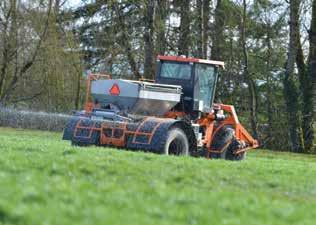
These combines don’t come cheap. This particular plot harvester is the same one that was purchased for OSRI last year and the same one that Pratum Coop recently purchased as well, a Zurn 160. It’s a very significant expense. But we have good researchers at OSU and, again, we felt it was in our best interest to provide the kind of equipment that will enable them to best do their work.
OSU Seed Services
OSU Seed Services
In wrapping up, I once again wish to thank the leadership at OSU and the USDA ARS unit in Corvallis for working with the industry and helping develop and support a significant new portfolio of research.
Collaboration doesn’t always come easily and these processes take time, but in the end, it certainly can pay dividends. F
Seed Lab
Seed Certification | seedcert.oregonstate.edu
Seed Certification | seedcert.oregonstate.edu
n Accurate and Timely Results
• Maintain pedigree of improved varieties
• Maintain pedigree of improved varieties
• Local
• Provide Seed
• Dedicated
• Seed
• Innovating
Partnering with Oregon’s Seed Industry for over 100 Years
Partnering with Oregon’s Seed Industry for over 100 Years
• Local participation through Advisory Committees
• Local participation through Advisory Committees
n AOSA & SCST analyst accreditations; ISTA lab accreditation
n Innovating for a changing industry
• Provide OECD (international) seed certification
• Provide OECD (international) seed certification
Seed Certification
Seed Laboratory | seedlab.oregonstate.edu
Seed Laboratory | seedlab.oregonstate.edu
• Dedicated to serving customers
• Dedicated to serving customers
n 24 hour access through eCertification
n Responsive team of Certification experts
• Seed testing services for a broad range of needs
• Seed testing services for a broad range of needs
• Maintain
• Local
• Provide Seed
• Dedicated
• Seed
n Provide OECD (International) Seed Certification Seed Years Seed
• Innovating for a changing industry
• Innovating for a changing industry
n Provide OECD (International) Seed Certification

• Innovating
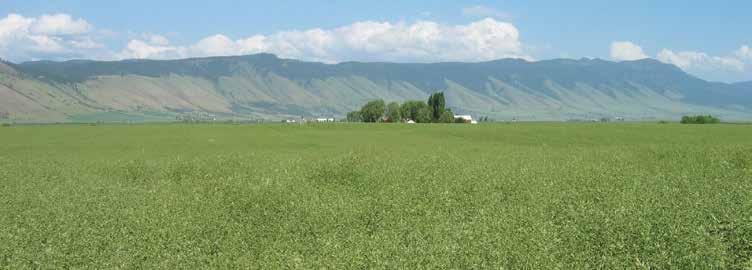
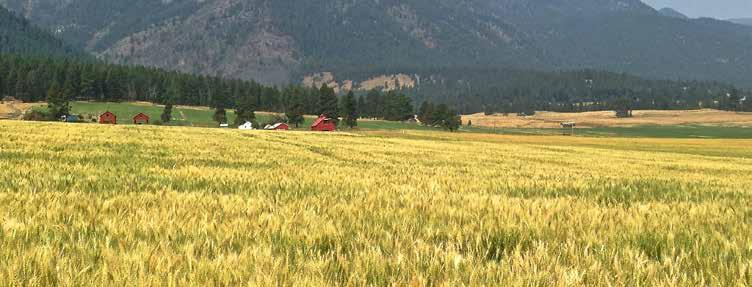
SPRING 2023 45 Commissions Update

Research & Regulatory Report
Steve Salisbury, Oregon Seed Council Research & Regulatory Coordinator
Springtime always brings an emphasis on what the goose migration is doing and when can the zinc phosphide (ZnP) broadcast applications begin. I am hopeful that by the time this column is published you will already be spreading ZnP wherever you need it. Historically speaking, the grass seed industry has received its approved special local needs (SLN) labels for ZnP baits somewhere between April 25 and May 10. The Oregon Departments of Agriculture and Fish and Wildlife have the procedures down pat and we will all spread the word as soon as we get the regulatory blessing to go ahead.
Of course, we have been hearing about the federal regulatory review on rodenticides that is still underway for several months now. Back around the first of December the EPA published their Proposed Interim Decision on rodenticides. This was a big step forward and everyone’s first look at what the agency was proposing to do with rodenticide use in the United States. To say the least, it was not an overly ag friendly proposal and has created many questions and uncertainties.
In response, several groups and individuals provided comments to the EPA during the public comment period. The EPA has updated their timeline of the registration review and indicates that their Interim Decision will be completed in 2024. That will be their final decision on rodenticides. In the meantime, we can expect to see the agency issue a biological evaluation of all the rodenticides under review in the fourth quarter of 2023. At that time, there will be another 60-day public comment period that will allow groups and individuals to again provide response for the agency to review.
Included in the EPA’s proposed risk mitigation language were items such as making all rodenticides restricted use, addition of respirators and thicker gloves to required PPE, required carcass search and removal and others. All measures would either increase the cost to the growers, would not be
feasible in production agriculture and/or eliminate uses all together.
One of the details proposed by the agency involved assigning a tolerance for ZnP to grass crops, which obviously would impact our use. A possible arbitrary assignment of a tolerance could be detrimental to the use of ZnP in grass grown for seed because if the assigned tolerance happens to be less than what aligns with our current labeled use pattern and rate, then the use on grasses grown for seed would be out of compliance with regulation. As a consequence, the labeled use pattern/rate would have to be revised.
This is alarming given that the common opinion in grass seed fields is that our labeled rate of 10 lbs. per acre broadcast is not high enough to accomplish acceptable control of voles. The overwhelming feeling from growers is “How do we get the label rate increased?” If the agency assigns a tolerance without basis for grass seed crops, then a viable discussion to increase our use rate would possibly fade-toblack.
What’s more frustrating with this issue is that years ago the IR-4 Project conducted the residue trials for ZnP on grass seed crops to support the establishment of tolerance for our crops. That data is still currently residing with IR-4 and we are waiting for the EPA to accept the data and request for tolerance. The agency did not accept the request or data previously because the current registration review was underway. Yes, the current review that is now potentially assigning a tolerance without even looking at the data that exists for grass seed crops. We should be grateful that we have the support of not only IR-4, but the Oregon Department of Agriculture, the Western IPM Center and OSU’s Specialty Crop Protection Program. We certainly appreciate the support. We will all keep our eyes on this as things progress through the process and hopefully keep the rate increase discussion alive.
46 Oregon Seed Magazine
Research & Regulatory Report
In the meantime, ZnP continues to be the labeled rodenticide option for vole control in grass seed crops. First, let’s all understand that ZnP does in fact kill voles and does a nice job of it. The challenge is getting the vole to eat enough to bring populations back into check. Field trials indicate that the voles willingness to eat ZnP baits seems to change from season to season and/or with field conditions. Like any other pest we deal with, biology is variable and always responds to its environment making management challenging.
So, if ZnP works when the vole ingests it, then the question should be how do we improve uptake? In other words, how can the palatability of the bait be improved? A research project funded by the grass seed industry was initiated in 2022-23 with the USDA National Wildlife Research Center in Fort Collins, Colorado where Dr. Aaron Shiels and colleagues are developing and testing attractants to improve vole control. They have also developed a practical coating
method for the attractant to be applied to the bait.
The last piece of this research project is to evaluate these attractant-bait combinations on the gray-tailed vole. Yes, the study is being conducted specifically on our vole. We will all anxiously await the performance data and keep our fingers crossed for an improved strategy with ZnP.
Of course, regulations and the future regulatory requirements imposed on rodenticides will have the ultimate say on our management strategies. The grass seed industry appears to be willing to stay the course with vole research and is willing to team up with key players to support our use within the regulatory discussions. Again, we thank the ODA, USDA, OSU, the registrants, the Western IPM Center and IR-4 for their support.
At the end of the day, our vole situation is not going away and neither should our focus and intent on finding better ways to address it
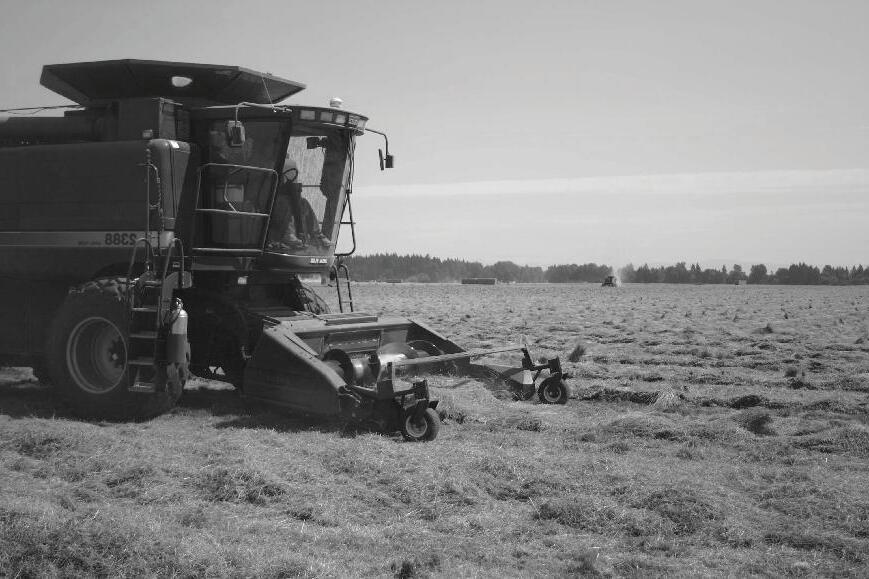
OREGON SEED BRINGING WORLD TO THE


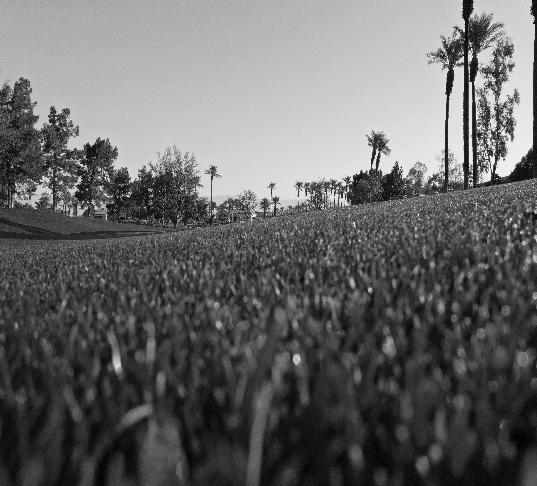


























Research & Regulatory Report 503.685.7555 WWW.OREGONSEED.ORG
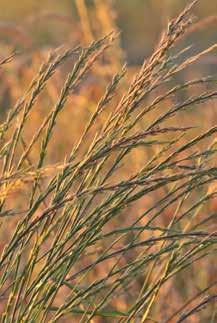
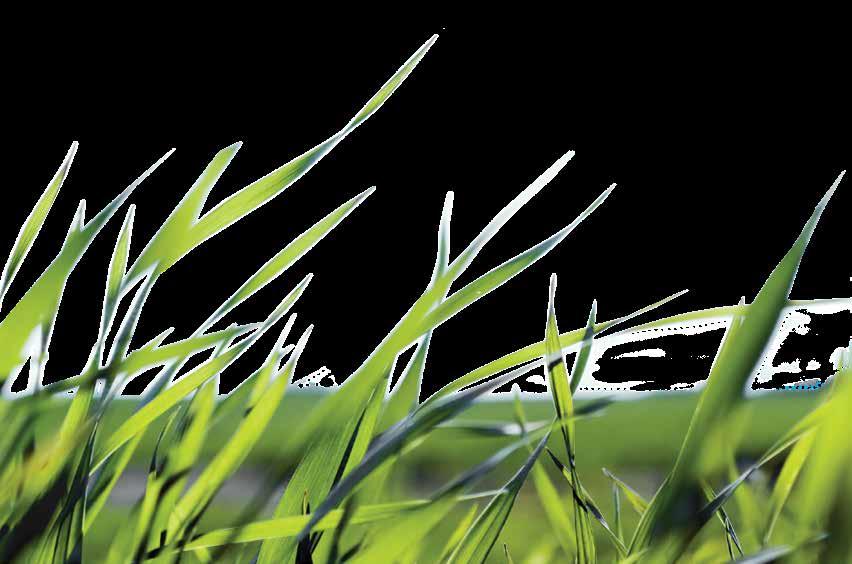
AgCultured Consulting ..................... 9 Ag Drainage Corp. 27 AgWest Farm Credit ......................... 5 American Ag Systems 25 AMVAC .............................................. 29 Axill Solutions 21 Barenbrug USA BC Citizens Bank ................................... 37 Creekside Valley Farms 44 FMC ................................................... 23 Ground and Water 40 Harvest Capital Company .............. 15 Hilton Trenching 30 Integrated Seed Growers LLC ....... 41 Liphatech, Inc. ................................. 35 Marion Ag Service 2 Neudorff .......................................... 13 Nutrien Ag Solutions, Inc. 10 ORCAL, Inc. ....................................... 17 Oregon Grass Seed Bargaining Association .................. 42 Oregon Seed Association 47 OSU Seed Services .......................... 45 Pratum Co-op 6-7 Sprague Pest Solutions .................. 31 Valley Agronomics LLC IBC West Coast Companies .................. 24 Wilbur-Ellis IFC, 32 CLASSIFIED ADS IN THE OREGON SEED MAGAZINE BRING RESULTS! Rates are $25 per 50 word insertion and 50¢ per additional word. Deadline for the Fall issue is August 16, 2023. Contact Shawn Anderson at (503) 364-3346, shawn@ostlund.com. Classifieds Calendar PLANT THE SEED AND WATCH IT GROW ADVERTISE WITH OREGON SEED MAGAZINE For more information contact Shawn Anderson at 503-364-3346 or shawn@ostlund.com May 17 Oregon Ryegrass Commission Meeting, 6 p.m., Cascade Grill 110 Opal St NE, Albany May 25 Oregon Tall Fescue Commission Meeting, 6 p.m., Roth’s, 1130 Wallace Rd. NW, Salem December 4-5 Oregon Seed League Annual Convention, Salem Convention Center, Salem Visit seedleague.org for more information Advertiser List
agronomy at its best


Spend more time in the field and less time in the office with Valley Agronomics Precision Ag.
Maximize your return on investment.
Valley Ag can help you increase the economic yield on your farm. advanced products
• knowledgeable crop advisors
• superior services


SPRING 2023 49
Chehalis Whiteson Cornelius Mount Angel Harrisburg Donald Stayton Rickreall
Plant a Legacy.
When you partner with Barenbrug USA, you can be assured that from our investments in research and development to our commitment to marketing and market education, you are planting more than just seed - you are planting a legacy. We believe in long-term relationships that bring stability to growers and value to our customers. Our team works to provide expertise, high seed yield, rotational crops, new and innovative varieties and exceptional value. From first planting to harvest to finished product you can be confident that your legacy is in good hands. Come grow with us. David
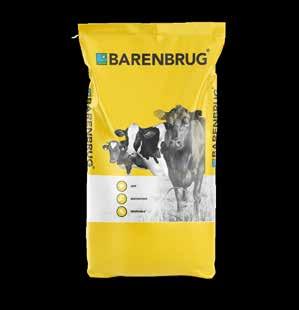


50 Oregon Seed Magazine
509-628-9011
VP
541-704-1217
Field
541-619-9971
Brawley Field Representative 541-936-2552 Liz Schlupe Field Representative 541-571-0575
Johnson Director of Production
Bo Lacy
Operations & Supply Chain
Mark Beitel
Representative
Josh













































 Megan Chuinard at the Capitol in Salem is replacing Roger Beyer as executive director of the Oregon Seed Council.
Megan Chuinard at the Capitol in Salem is replacing Roger Beyer as executive director of the Oregon Seed Council.
























 Braden and Jim Anderton of Mode Transportation.
A general load diagram with double drop void fillers provided by Albany Box Company.
Braden and Jim Anderton of Mode Transportation.
A general load diagram with double drop void fillers provided by Albany Box Company.












































































